Physical Address
304 North Cardinal St.
Dorchester Center, MA 02124
This chapter addresses the initial approach to a patient with suspected or known heart disease with the physical examination, chest x-ray, and electrocardiogram (ECG). A proper initial assessment helps to avoid unnecessary testing. However, the practice of cardiology as a pediatric subspecialty continues to rapidly evolve with expansion and enhancement of imaging technology and therapeutic options. Complex structural congenital anomalies can be precisely defined by a combination of techniques that include echocardiography, cardiac catheterization with angiography, nuclear imaging, magnetic resonance imaging (MRI), and computed tomography (CT) angiography. Concomitant with advances in diagnostic capabilities have come remarkable advances in therapy, both surgical and by interventional catheterization. Therefore this chapter includes considerable material on echocardiography and color flow Doppler studies, which remain the preeminent imaging modalities in pediatric cardiology. In addition, the surgical procedures that are commonly used are described, and an up-to-date section on the expanding array of therapeutic options in the cardiac catheterization laboratory is included in this chapter.
The three prerequisites to a good cardiovascular examination are a proper environment, a cooperative child, and the conviction on the part of the physician that the examination is important. A heart murmur is not the only part and often is not even the most important part of the cardiac physical examination. Blood pressure determination, character of the pulse and precordial activity, observation of cyanosis, clubbing of the nail beds of the fingers or toes, and dysmorphic facial or other physical features may provide clues to the diagnosis and nature of congenital heart lesions before auscultation is even performed.
The physical examination should begin with a general inspection of the patient. Attention should be paid to the general appearance (well appearing vs. ill appearing), nutritional status (well-nourished vs. failure to thrive), color, and presence of dysmorphic physical features. In addition, the patient’s preferred position should be noted. Patients with significant myocardial dysfunction, pulmonary edema, or pericardial disease are often most comfortable in a seated position. Placing these types of patients into a supine position may precipitate respiratory distress. Finally, the respiratory rate and work of breathing should be assessed at each encounter. Patients with cyanotic heart disease may manifest peaceful tachypnea, which is secondary to hypoxia. In contrast, patients with significant pulmonary overcirculation manifest labored tachypnea (e.g., grunting, retractions).
Even before mild desaturation is detectable, early clubbing and cyanosis may be seen ( Figs. 5.1 and 5.2 ). The base of the nail, especially the thumbnail, may show loss of the angle as early as 3 months old (see Chapter 17 ). Elevated hemoglobin and hematocrit and loss of nail angle indicate hypoxemia and the presence of a right-to-left intracardiac shunt ( Fig. 5.3 ). If heart disease is excluded, chronic pulmonary disease should be considered. Less common causes of clubbing include disorders of the central nervous system, liver disease, and malabsorption syndromes. Observation of the lips and mucous membranes for the presence of cyanosis is best done in good daylight because fluorescent lighting may produce a false cyanotic tinge. In the presence of polycythemia with hemoglobin in the 18% to 20% g range and hematocrit greater than 60%, the conjunctival vessels become engorged and plethoric (see Fig. 5.2 ). Conversely, when a patient is anemic, visible cyanosis can be easily missed (this is particularly important in infancy when babies reach physiologic nadir in hematocrit). Differential cyanosis between the upper and lower extremities is an unusual clinical finding. If the patient has pulmonary vascular disease, reverse flow through a patent ductus arteriosus with no right-to-left intracardiac shunting, cyanosis, and clubbing may be found in the lower extremities but not in the hands ( Fig. 5.4 ).
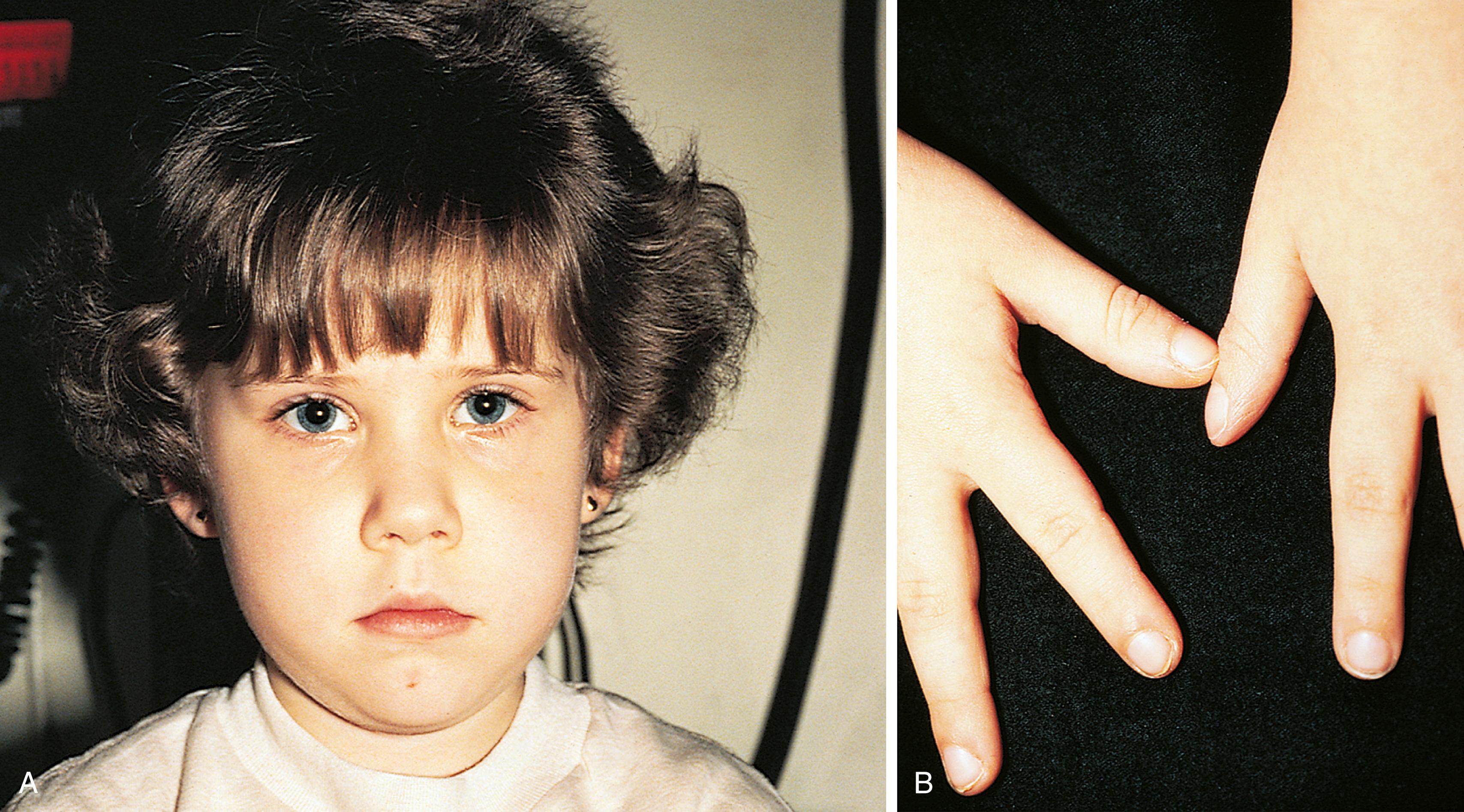


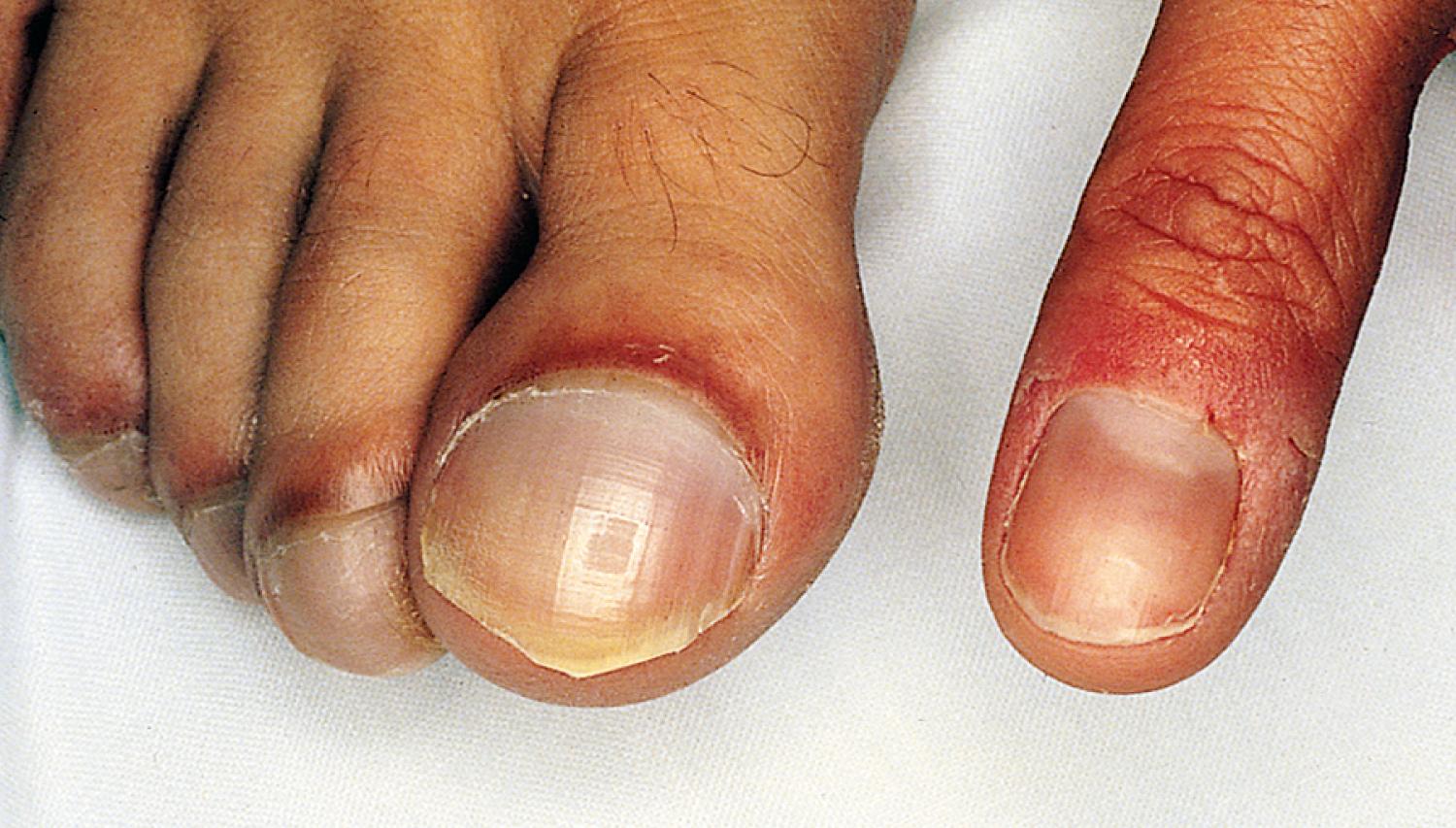
Blood pressure determination in infants and children is an integral part of the cardiac physical examination. Attention to proper cuff size prevents the misdiagnosis of systolic hypertension from an undersized cuff. In general, it is better to use an oversized cuff, because overestimation in systolic blood pressure can be avoided. Blood pressure can be tracked in children over time, and tables depicting normal blood pressure range for age have been published. Blood pressure determination in both arms and a lower extremity will detect coarctation of the aorta. Supravalvar aortic stenosis may produce discrepant blood pressure readings between the left and right arms. In this condition, the jet of supravalvar stenosis is felt to be directed preferentially toward the right wall of the aorta and into the innominate artery. This is an example of the Coanda effect (a fluid column’s proclivity after emerging from an orifice to adhere to a surface and flow along it). Blood pressure determination can also help to assess the severity of aortic valve disease, including aortic valve stenosis (narrow pulse pressure) and aortic regurgitation (wide pulse pressure).
Murmurs are relatively common in the newborn period. A common innocent heart murmur, peripheral pulmonic stenosis (PPS), during this period originates from the branch pulmonary arteries because of their relatively small size compared with the main pulmonary artery resulting from the normal fetal flow pattern, which delivers limited flow to the right and left pulmonary arteries. Characteristically, this murmur is early systolic and loudest over both axillae and the back. The murmur of branch pulmonary artery stenosis has the same distribution as the structural lesions that cause increased pulmonary blood flow. A transient systolic murmur at the middle-low left sternal border in the normal newborn can be due to tricuspid regurgitation, and a soft systolic ejection murmur at the upper left sternal border may arise from a closing patent ductus arteriosus. A large ventricular septal defect does not produce a murmur in the newborn period because the initially high pulmonary vascular resistance results in minimal shunting across the defect. On the other hand, pathologic systolic murmurs in the newborn are caused by restrictive ventricular septal defects, lesions producing left and right ventricular outflow tract obstruction (i.e., tetralogy of Fallot [TOF] and valvular aortic or pulmonary stenosis), and significant atrioventricular valvar insufficiency. In the newborn, it can be difficult to distinguish the murmur of a small restrictive ventricular septal defect from that of a severe right ventricular outflow tract obstruction in TOF or left ventricular outflow obstruction. The implications of this differential diagnosis are such that an echocardiogram is recommended for infants with this clinical presentation.
Contrary to popular belief, the presence of a continuous murmur from a patent ductus arteriosus is extremely rare in a full-term newborn. This is because the normal elevation of pulmonary artery pressure at this age minimizes the diastolic gradient between the aorta and pulmonary artery, attenuating or eliminating any diastolic component of the murmur. If a continuous murmur is heard in the newborn, patent ductus–dependent pulmonary blood flow or systemic to pulmonary collateral vessels in association with pulmonary atresia complex should be considered.
Preschoolers and school-age children are commonly referred for evaluation of a heart murmur. Innocent murmurs of childhood fall into four major categories: systolic ejection murmurs at the base; vibratory, or Still murmur; venous hums; and carotid and cranial bruits. In most instances, there are associated clinical and laboratory studies that can distinguish the innocent from the pathologic murmur. Table 5.1 summarizes the distinguishing features and differential diagnosis. Fig. 5.5 illustrates the sites where murmurs resulting from various cardiovascular lesions are best heard.
| Innocent Heart Murmur | Structural Congenital Heart Disease |
|---|---|
| Systolic Ejection Murmur at the Base of the Heart | |
| High left sternal border | Pulmonary valve stenosis |
| (Pulmonary Flow Murmur) |
|
|
|
| Atrial septal defect | |
|
|
|
|
|
|
| High right sternal border | Aortic valve stenosis |
|
|
|
|
| Still Murmur | |
| Vibratory quality | Ventricular septal defect |
| Location: Left midsternal border |
|
| Discrete subaortic stenosis | |
|
|
| Subpulmonic stenosis | |
|
|
|
|
| Venous Hum | |
| Continuous | Patent ductus arteriosus |
| Location: Neck and under clavicles |
|
| Usually loudest when sitting, disappears in supine posture | Coronary atrioventricular malformation |
|
|
| Carotid and Cranial Bruits | |
| Murmur over carotids and head | Aortic stenosis |
| Atrioventricular malformation | |
|
|
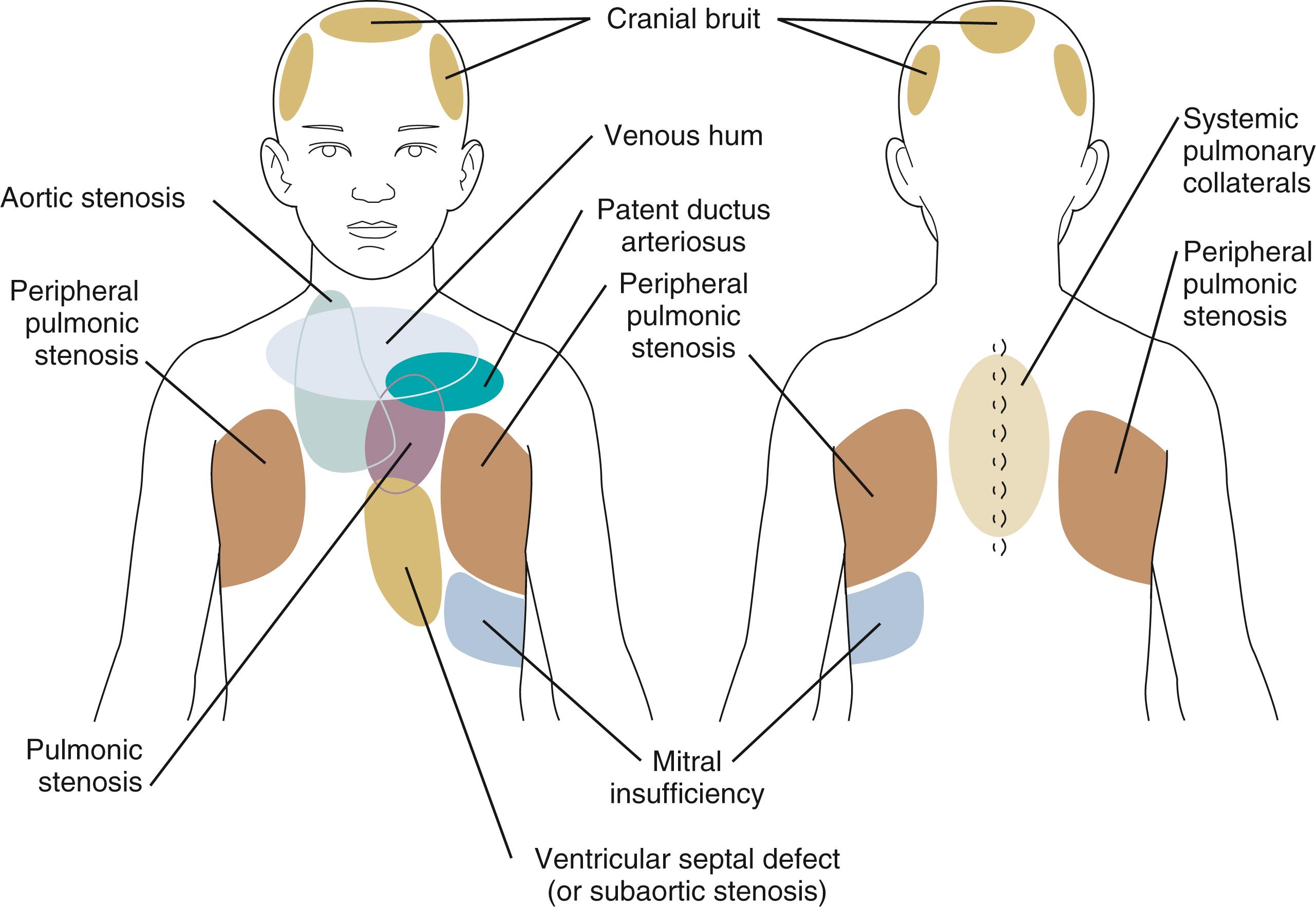
Dysmorphology of the face and habitus suggests certain syndromes associated with congenital heart disease ( Table 5.2 ).
| Syndrome | Genetic Basis of Disease | Common Cardiac Defect |
|---|---|---|
| Alagille | Mutation of JAG-1 gene | Peripheral branch pulmonary artery stenosis, tetralogy of Fallot, pulmonary valve stenosis, atrial and ventricular septal defects |
| CHARGE | Mutation of CHD7 gene | Tetralogy of Fallot, double outlet right ventricle, truncus arteriosus, aortic arch abnormalities, patent ductus arteriosus, ventricular septal defects, atrial septal defects, and atrioventricular septal defects. |
| DiGeorge/velocardiofacial | Deletion of 22q11 | Aortic arch abnormalities: interrupted arch (type B), right aortic arch |
| Conotruncal abnormalities: truncus arteriosus, tetralogy of Fallot, pulmonary atresia with ventricular septal defect | ||
| Ellis-van Creveld | Mutation of EVC gene (4p16) | Atrial septal defect or common atrium |
| Fetal alcohol | N/A | Ventricular septal defect |
| Holt-Oram | Mutation of TBX-5 gene | Atrial and ventricular septal defects, arrhythmias |
| Marfan | Mutation of Fibrillin 1 gene | Dilation of ascending aorta/aortic sinus, aortic, mitral valve prolapse, mitral insufficiency |
| Noonan | Mutation in PTPN 11 gene in ∼50%. Mutation of multiple genes in the Ras-MAPK pathway |
Dysplastic pulmonic valve, atrial septal defect, hypertrophic cardiomyopathy |
| Turner | 45 X monosomy | Coarctation of the aorta, bicuspid aortic valve |
| Williams | Microdeletion of 7q11.23 region | Supravalvular aortic stenosis, pulmonary artery stenosis |
| Trisomy 13 | Patent ductus arteriosus, septal defects, pulmonic and aortic stenosis (atresia) | |
| Trisomy 18 | Ventricular septal defect, polyvalvular disease, coronary abnormalities, double outlet right ventricle with mitral atresia, tetralogy of Fallot | |
| Trisomy 21 (Down syndrome) | Atrioventricular septal defects, ventricular septal defect, patent ductus arteriosus, anomalous subclavian artery | |
| VACTERL association | Unknown | Ventricular septal defects, atrial septal defects, tetralogy of Fallot |
The typical features in Down syndrome (trisomy 21) are discussed in Chapter 1 . Approximately 40% of children with this syndrome have structural lesions, such as atrioventricular septal defects (complete or partial atrioventricular septal defect), isolated ventricular septal defects, patent ductus arteriosus, or anomalous origin of the subclavian arteries. Although many infants with Down syndrome and congenital heart disease have chronic congestive heart failure and growth failure, there is a subset with a significant septal defect who may grow and develop appropriately. This is related to abnormally high pulmonary vascular resistance not decreasing in the usual fashion in this group, leading to early pulmonary vascular disease. Because this presentation may be silent, it is important that all children with Down syndrome be thoroughly evaluated during early infancy. The evaluation should include an echocardiogram to rule out congenital heart disease.
DiGeorge and velocardiofacial syndromes are related developmental disorders involving the third and fourth pharyngeal pouches. They have been shown to be caused by deletions within a critical region of chromosome 22q11 (which can be evaluated with a blood test—fluorescence in situ hybridization [FISH] for 22q11 deletion). Cardiac abnormalities, particularly the conotruncal type and aortic arch anomalies, occur in 75% of patients with 22q11 deletion (see Table 5.2 ). Other findings include hypocalcemia, cleft palate, renal anomalies, immunologic defects, facial dysmorphisms, and variable developmental delay with educational and behavioral issues (see Chapter 4 ).
Ellis-van Creveld syndrome is an autosomal recessive disorder characterized by multiple gingival frenula, natal teeth, and polydactyly ( Fig. 5.6 ). The patient with this syndrome frequently has an atrial septal defect or a common atrium.
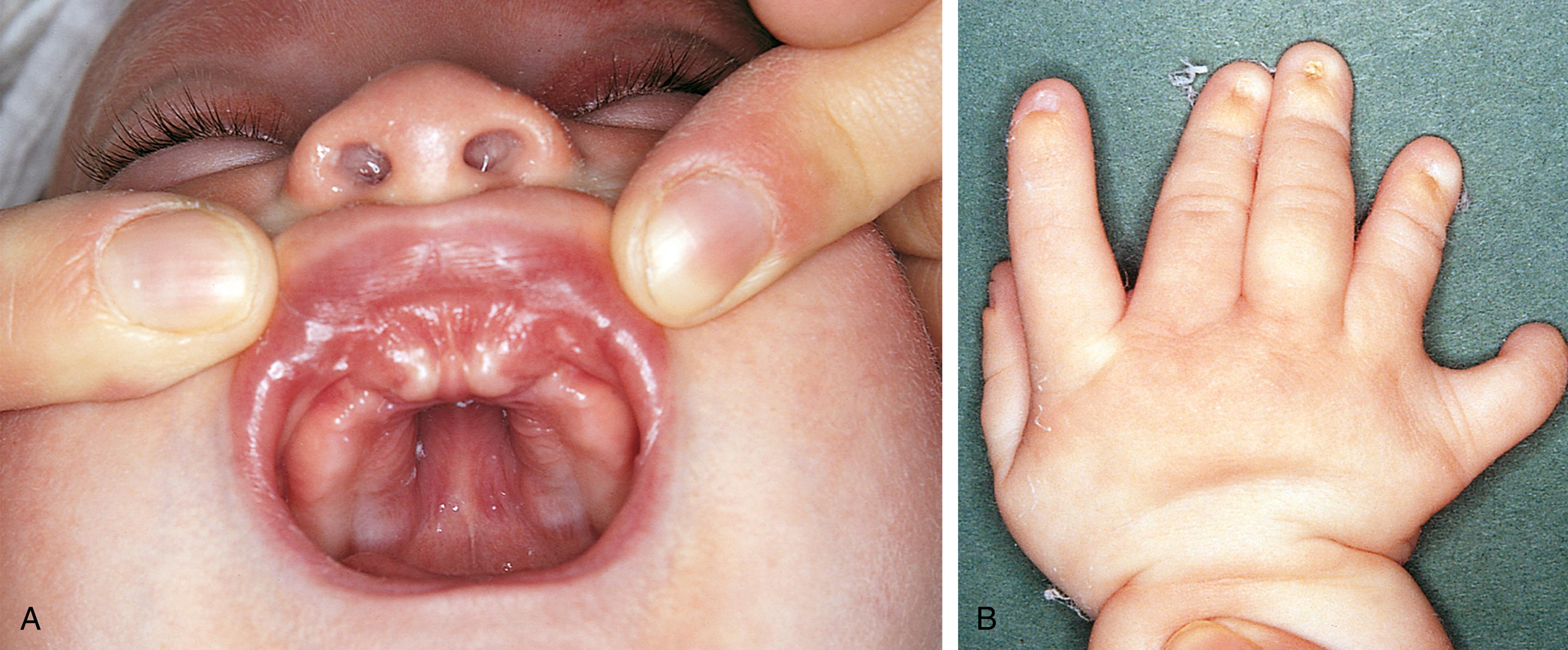
Holt-Oram syndrome, an autosomal dominant disorder, is associated with upper limb deformities consisting of narrow shoulders, hypoplasia of the radius, and phocomelia ( Fig. 5.7 ). Absence of both radius and thumb or proximal displacement of the thumb is the most frequent finding. Commonly associated cardiovascular abnormalities include an atrial septal defect, ventricular septal defect, and arrhythmias (atrial and ventricular ectopy and atrioventricular block).
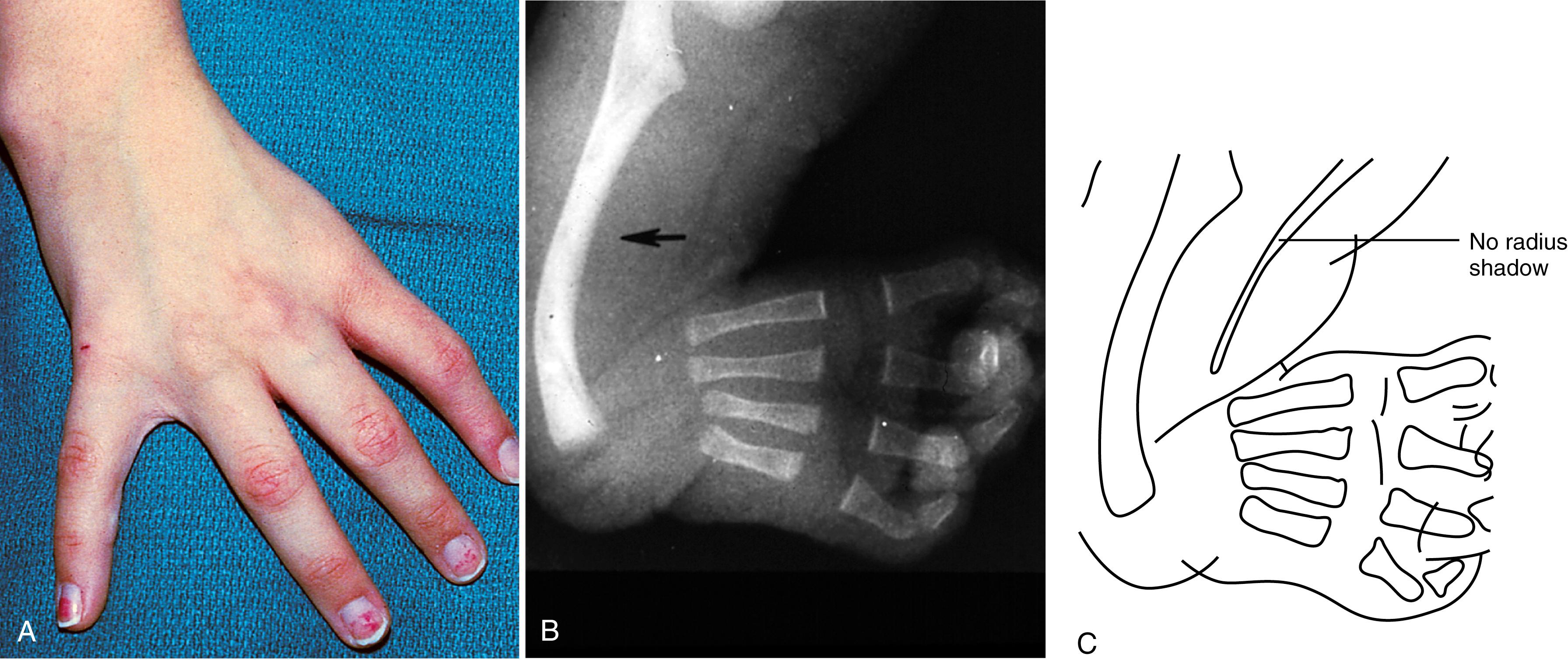
Marfan syndrome also has an autosomal dominant inheritance; it manifests as a connective tissue disorder in which the elastic fibers are disrupted, causing cystic medial necrosis of the aorta, as well as joint laxity and subluxation of the ocular lens. Affected patients are tall, with increased limb length compared with the trunk. Their arm span exceeds their height. The cardiovascular abnormalities nearly always found in this syndrome include aneurysmal dilation of the aorta and aortic sinuses and mitral valve prolapse. Associated aortic and mitral valve regurgitation are common ( Fig. 5.8 ) (see Chapter 1 ).
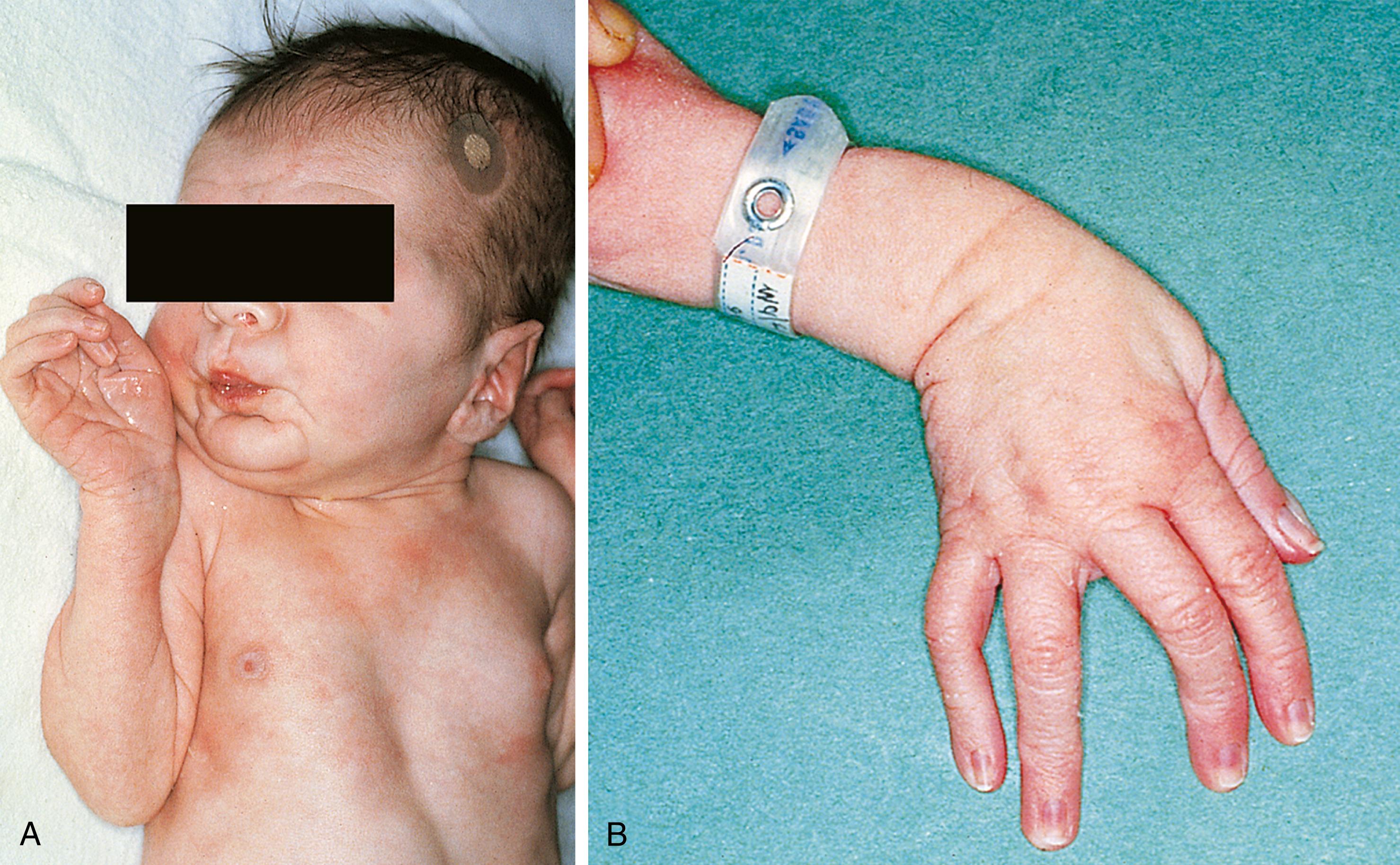
Cardiac anomalies occur in up to 50% of patients with Turner syndrome. The most common lesions include bicuspid aortic valve, coarctation of the aorta, and dilation of the aorta. (See Chapters 1 and 9 for a detailed discussion of Turner syndrome.)
Patients with Noonan syndrome have features characteristic of Turner syndrome but possess a defect on chromosome 12 and may be male or female. An autosomal dominant inheritance pattern accounts for approximately 50% of Noonan cases. Clinically, these children have the findings of webbing of the neck, pectus excavatum, shield chest with widely spaced nipples, short stature, epicanthal folds, low-set ears, and increased carrying angle of the arms ( Fig. 5.9 ). Common cardiovascular defects include pulmonary stenosis in association with a dysplastic pulmonary valve, atrial septal defect, and hypertrophic cardiomyopathy. Occasionally, there may be dysplasia of all cardiac valves. The ECG may show a left axis deviation that is unrelated to other structural abnormalities. The syndrome appears as an autosomal dominant disorder; multiple members of a family are often affected.
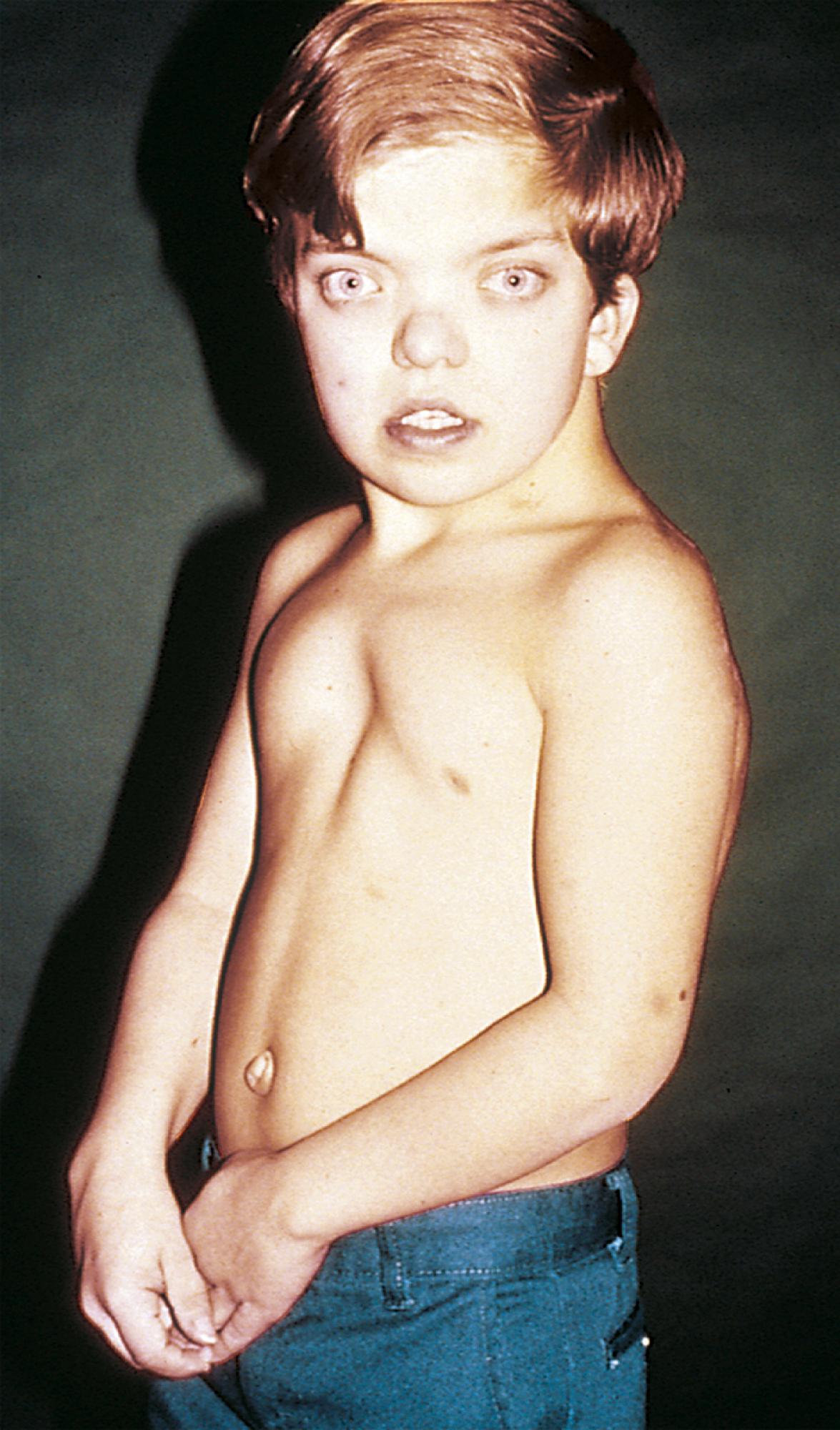
Patients with Williams syndrome characteristically have “elfin” facies: a broad maxilla, a small mandible with full mouth and large upper lip (philtrum), upturned nose, and a full forehead ( Fig. 5.10 ). This syndrome has been associated with hypercalcemia in infants and a strikingly affable personality despite variable degrees of developmental delay and has an identifiable genetic abnormality, a deletion of the 7q11.23 region of chromosome 7 containing the elastin gene. Supravalvular aortic stenosis and pulmonary artery branch stenosis are the common cardiovascular abnormalities associated with this syndrome.

Alagille syndrome is attributable to mutations in the JAG-1 gene. The majority of patients have congenital heart disease, with peripheral branch pulmonary artery stenosis being the most common manifestation. TOF with pulmonary stenosis or atresia, pulmonary valve stenosis, and atrial and ventricular septal defects are also associated with the condition.
CHARGE (coloboma, heart disease, atresia choanae, retarded growth and development, genital anomalies, and hypogonadism, ear anomalies and deafness) association features congenital heart disease in approximately 50% to 70% of cases. Common lesions include TOF, double outlet right ventricle, truncus arteriosus, aortic arch abnormalities, patent ductus arteriosus, ventricular septal defects, atrial septal defects, and atrioventricular septal defects.
In addition, there are many other genetically determined diseases and inborn errors of metabolism with cardiac involvement, the most common of which are listed in Table 5.3 .
| Syndromes | Cardiac Findings |
|---|---|
| Genetically Determined Diseases | |
| Metabolic | |
| Pompe disease (glycogen storage) | Cardiomyopathy (storage of glycogen in myocardium) |
| Mucopolysaccharidosis | Storage of MPS in arteries, coronaries, and valves with insufficiency and stenosis |
| Hurler syndrome (MPS I H), Hunter syndrome (MPS II), Scheie syndrome (MPS IS), Hurler-Scheie syndrome (MPS IH/S), Morquio syndrome (MPS IV) | |
| Hyperlipoproteinemia, familial type II | Premature atherosclerosis of arteries including coronaries |
| Neurologic | |
| Friedreich ataxia | Cardiomyopathy (congestive or hypertrophic) |
| Muscular dystrophies | Myocardial degeneration and fibrosis |
| Inborn Error of Metabolism (No Proven Genetic Basis) | |
| Progeria | Hypercholesterolemia, atherosclerotic changes in arteries, including coronary arteries |
Examination of the skin in a patient with acute rheumatic fever may reveal the typical rash of erythema marginatum, although this rash is not specific for rheumatic fever. It is evanescent, is nonpruritic, has sharp serpiginous margins, and is found on the inner aspects of the upper arms and thighs and on the trunk ( Fig. 5.11 ). The differential diagnosis includes (1) drug rash, which is papular and pruritic; (2) erythema multiforme, which has target lesions; (3) rash of juvenile rheumatoid arthritis, which is pink, macular, and lacks wavy margins, and which may be transient; and (4) the cutaneous findings of Kawasaki disease (see Chapter 7 ).
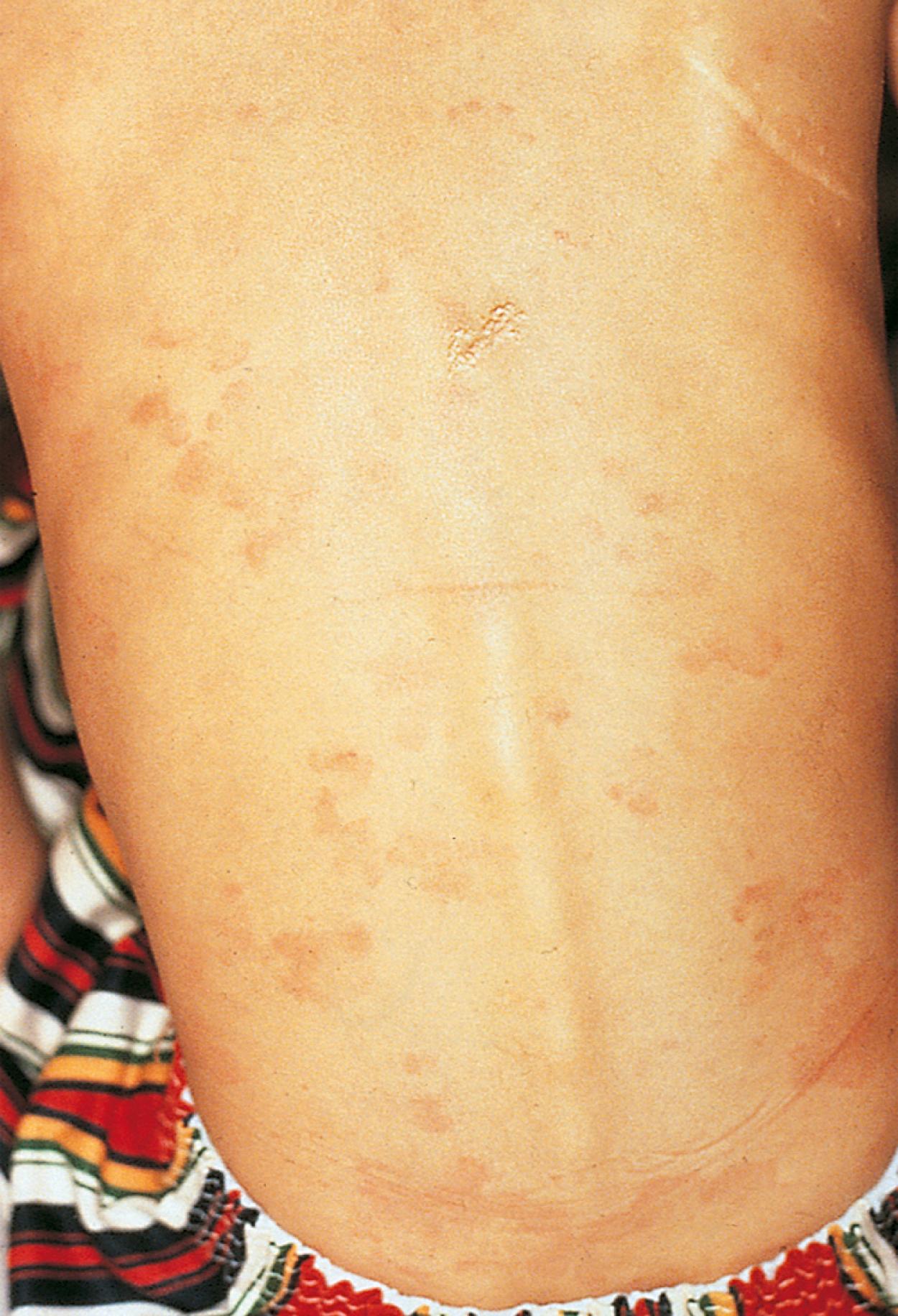
Subcutaneous nodules are rare in chronic rheumatic heart disease, but if found, they are almost always associated with severe carditis. These movable, nontender, cartilage-like swellings vary in size from 2 mm to 1 cm and are persistent. They are seen over the bony prominences of the large joints and external surfaces of the elbows and knuckles of the hands, knees, and ankles. They may also be felt along the spine and over the skull. Although difficult to photograph, they are easily palpated ( Fig. 5.12 ).
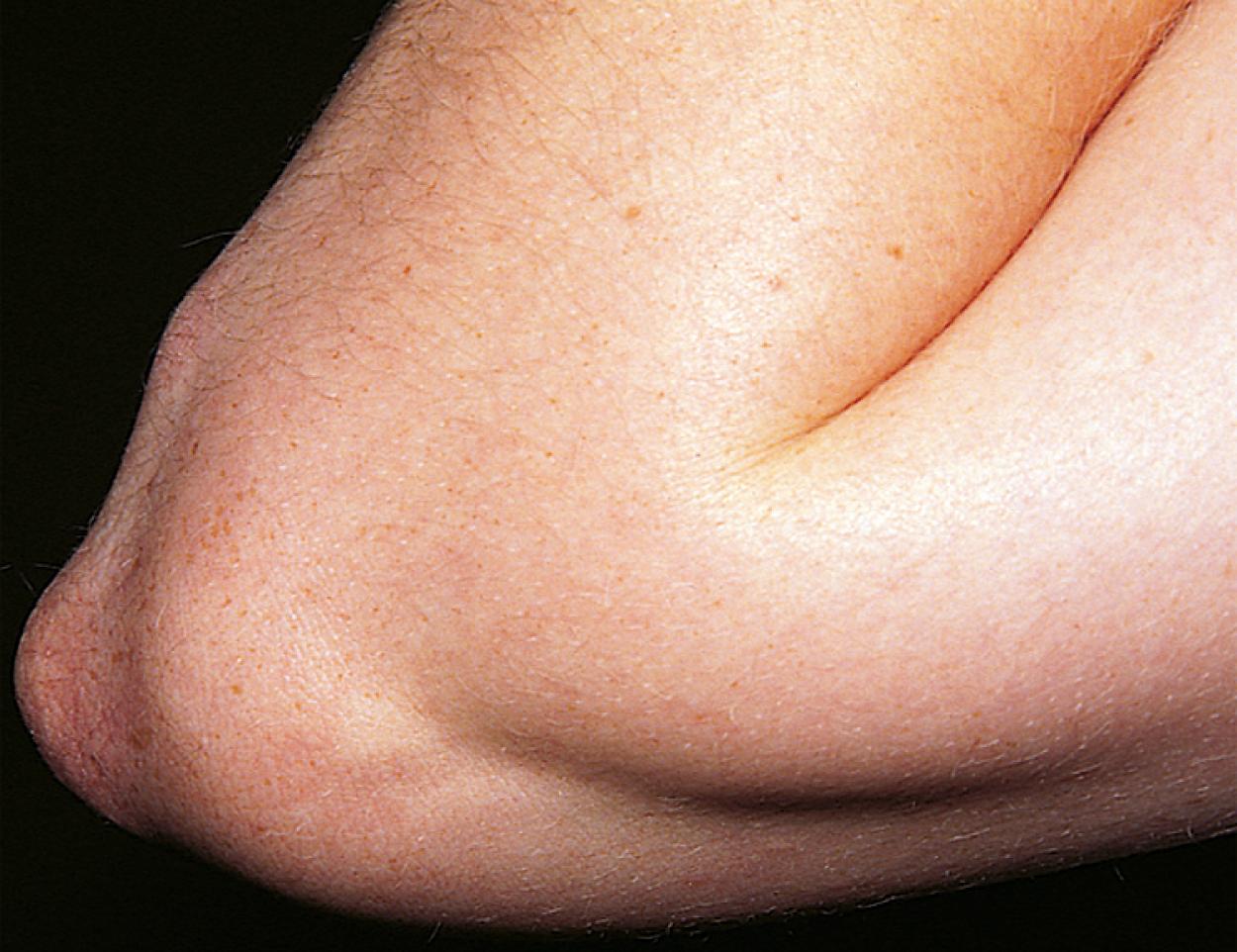
At least half of patients with acute rheumatic fever have cardiac involvement. Mitral regurgitation is the most common manifestation, and mitral stenosis may subsequently develop. Aortic regurgitation may also be noted, whereas aortic stenosis is uncommon. The cardiac physical examination may reveal distinctive findings of a parasternal lift and loud pulmonic closure sound from secondary pulmonary hypertension, an apical pansystolic high-pitched murmur of mitral regurgitation, a mid-diastolic apical rumble (Carey Coombs murmur) from increased and turbulent flow across thickened mitral valve leaflets, and a high-pitched decrescendo diastolic murmur at the left sternal border of aortic regurgitation.
Although the clinical presentation of bacterial endocarditis varies according to the infecting organism, it should be suspected in any patient with congenital or acquired heart disease who has prolonged fever without apparent cause. The classic skin lesions include petechiae, splinter hemorrhages of the nails, conjunctival hemorrhages, Janeway lesions ( Fig. 5.13 ), and Osler nodes. Vegetations occasionally dislodge and embolize in an end artery, which results in hemorrhagic or gangrenous lesions ( Fig. 5.14 ). Janeway lesions are nontender, small erythematous lesions noted on the palms and soles. Osler nodes, which present as small tender erythematous nodules, are found in the intradermal pads of the fingers and toes or in the thenar or hypothenar eminences ( Fig. 5.15 ). Both Janeway lesions and Osler nodes are believed to be a manifestation of vasculitis with deposition of circulating immune complexes leading to inflammation and central necrosis. The difference in the appearance, location, and sensation is unknown. All the aforementioned findings are often associated with a new heart murmur, splenomegaly, spiking fever, and positive blood culture. Clubbing of the fingers may occur in chronic cases.
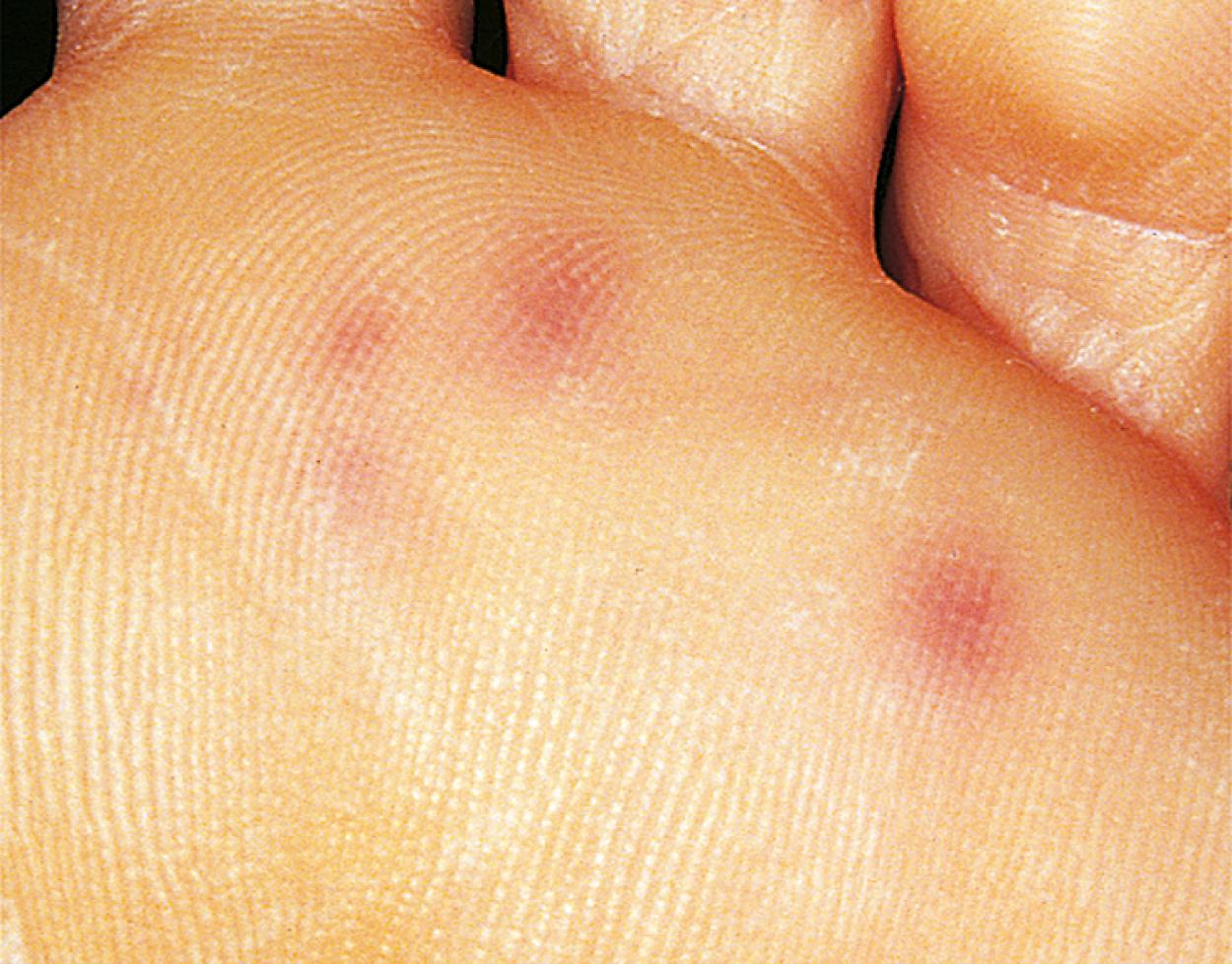
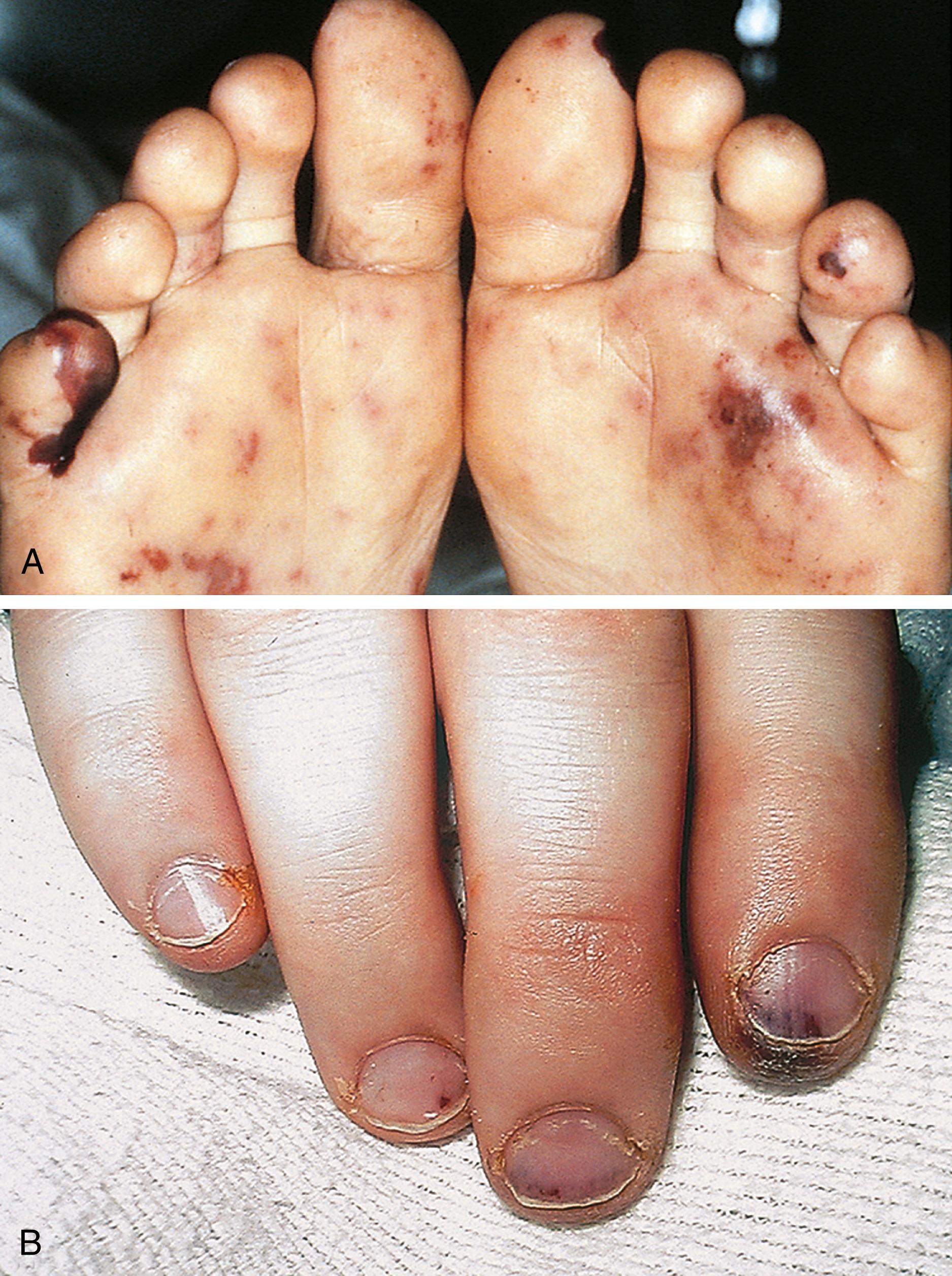
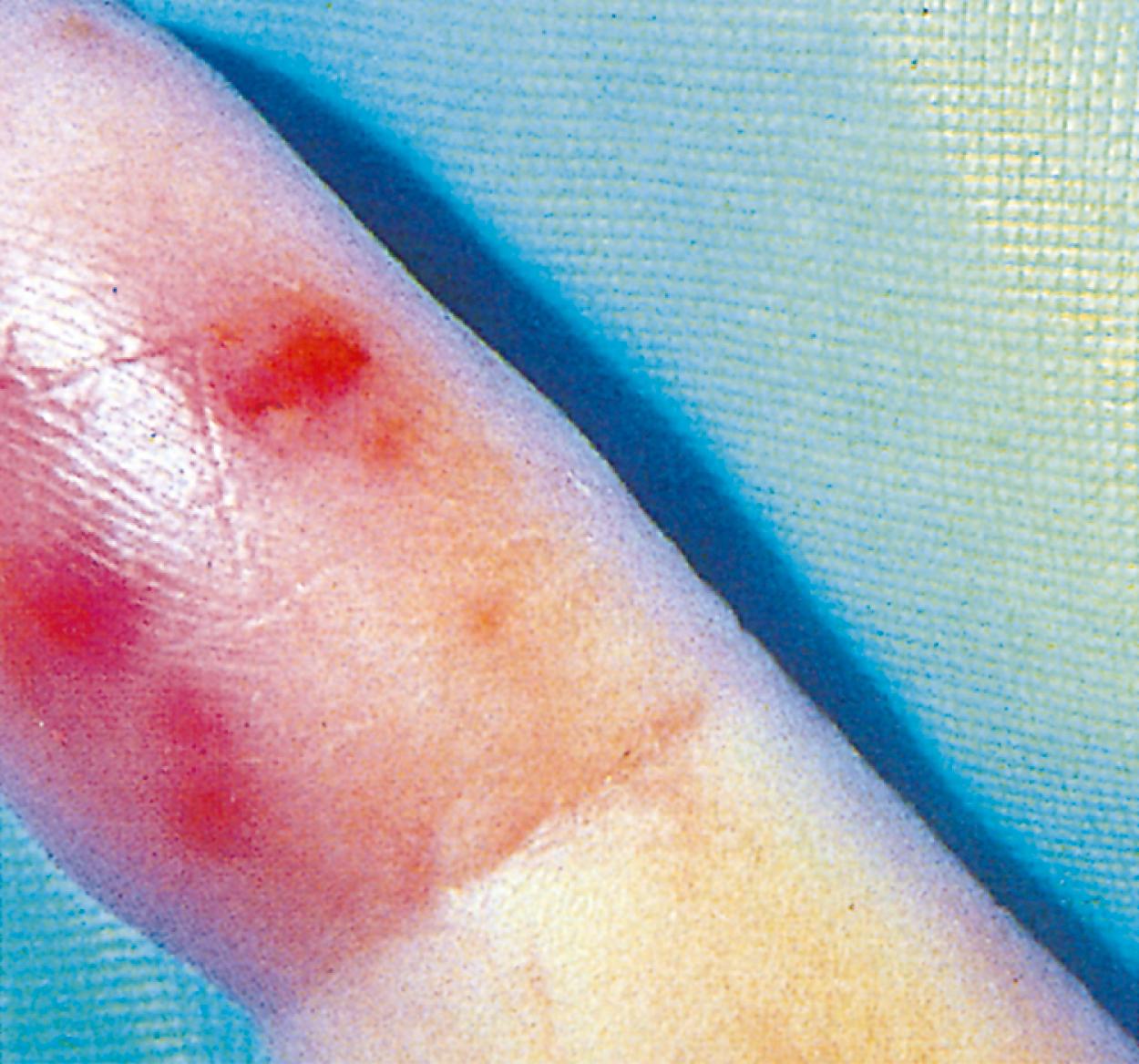
This multisystem disease has surpassed acute rheumatic fever as the most common form of acquired heart disease in children. It is characterized by fever, conjunctivitis, erythema of the lips and oral mucosa, extremity changes, rash, and cervical adenopathy. Coronary artery aneurysms develop in 15% to 25% of untreated patients and may result in myocardial ischemia, infarction, or sudden death. The incidence of coronary abnormalities is markedly decreased with timely treatment (≈5%). This disease is discussed in detail in Chapter 7 . Coronary artery aneurysms are well demonstrated by echocardiography ( Fig. 5.16 ), and this imaging modality plays an essential role in the diagnosis and management of Kawasaki disease.
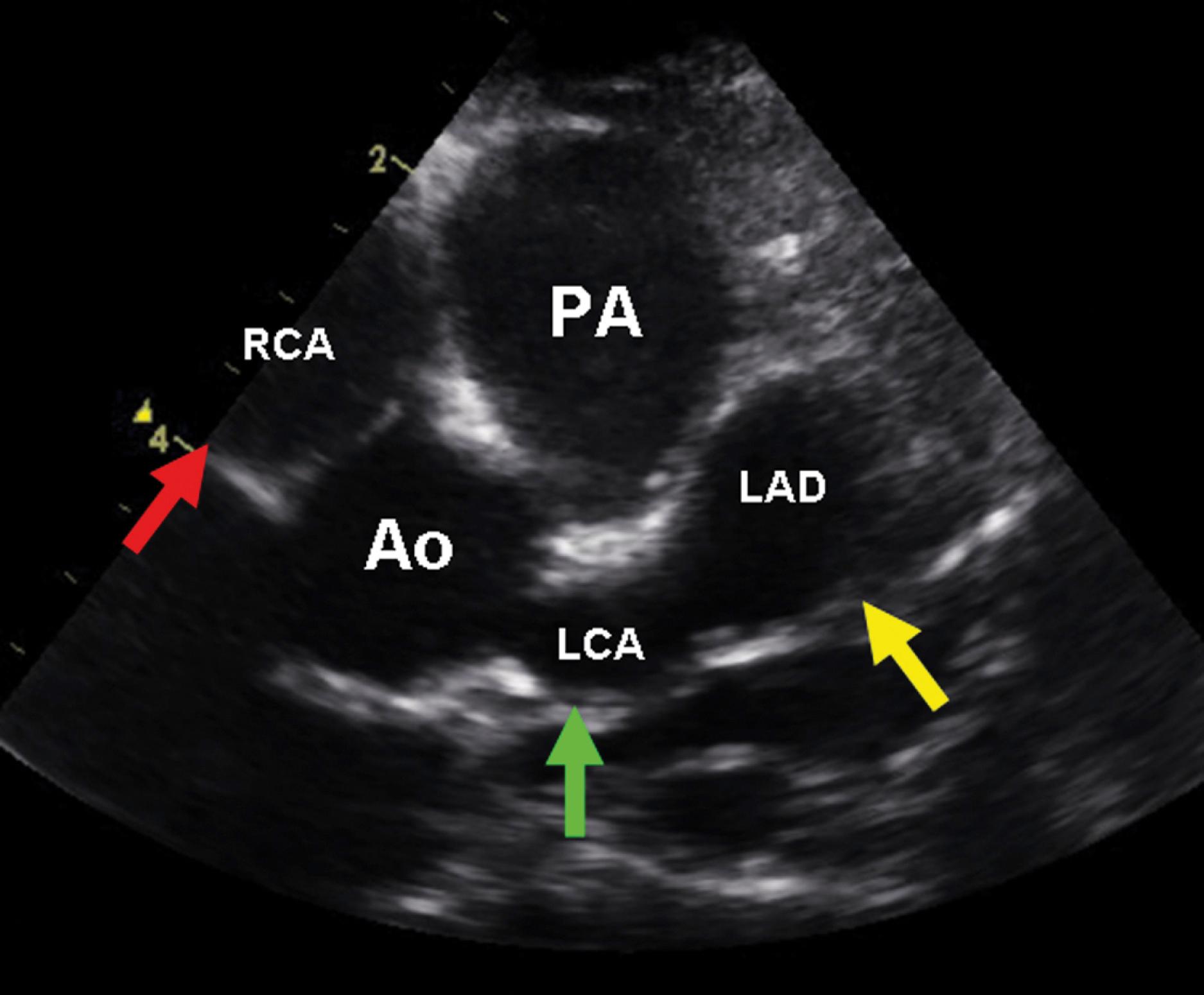
In addition to a comprehensive physical examination, the chest roentgenogram, ECG, and, most notably, echocardiography provide invaluable information concerning specific congenital heart lesions and have allowed therapeutic decisions to be made without cardiac catheterization.
The chest x-ray examination is useful to screen patients with suspected congenital heart disease. Chest x-ray can identify enlargement of the cardiac silhouette, which could signify chamber enlargement or pericardial effusion. In addition, pulmonary vascular markings can help to identify diseases with increased pulmonary blood flow such as left-to-right shunts, or diminished pulmonary blood flow in cyanotic lesions such as TOF. The chest x-ray is also useful in differentiating cardiac from pulmonary pathology such as pneumonia, pneumothorax, pneumomediastinum, or other parenchymal lung disease that may mimic congenital heart disease. The review of any chest roentgenogram requires a systematic approach.
The location of the cardiac apex and visceral situs provides important diagnostic information. Discordance of the situs and cardiac apex (i.e., apex to the right with situs solitus [normal arrangement] or apex to the left with situs inversus) is often associated with structural congenital heart disease ( Fig. 5.17 ). Dextrocardia (apex to the right) or mesocardia (apex to the middle) with situs solitus is a frequent presentation of ventricular inversion or corrected transposition of the great arteries (see Fig. 5.17 ). Dextrocardia with situs inversus totalis can be identified on chest x-ray with the apex pointing to the right and the stomach bubble also on the right ( Fig 5.18 ). Dextrocardia can also be seen with primary pulmonary problems. Scimitar syndrome is composed of dextroposition with hypoplasia of the right lung. In this case, a major portion of the right lung (usually the right lower lobe) is “sequestered” and has its arterial supply by way of a systemic artery from the descending aorta, and the pulmonary venous return from that lung drains abnormally into the inferior vena cava via a vein forming a scimitar ( Fig. 5.19 ). Patients with levocardia (apex to the left) with either situs inversus or situs ambiguous frequently have complex congenital heart diseases, such as transposition of the great arteries, pulmonary atresia, and atrioventricular septal defects. Atrial isomerism is associated with bilateral morphologic right or left lungs and can be recognized as bilateral symmetric right (short) or left (long) bronchi. This is best demonstrated with a magnified penetrated chest x-ray examination focusing on bronchial anatomy ( Fig. 5.20 ). Many patients with this anomaly have complex congenital heart disease.
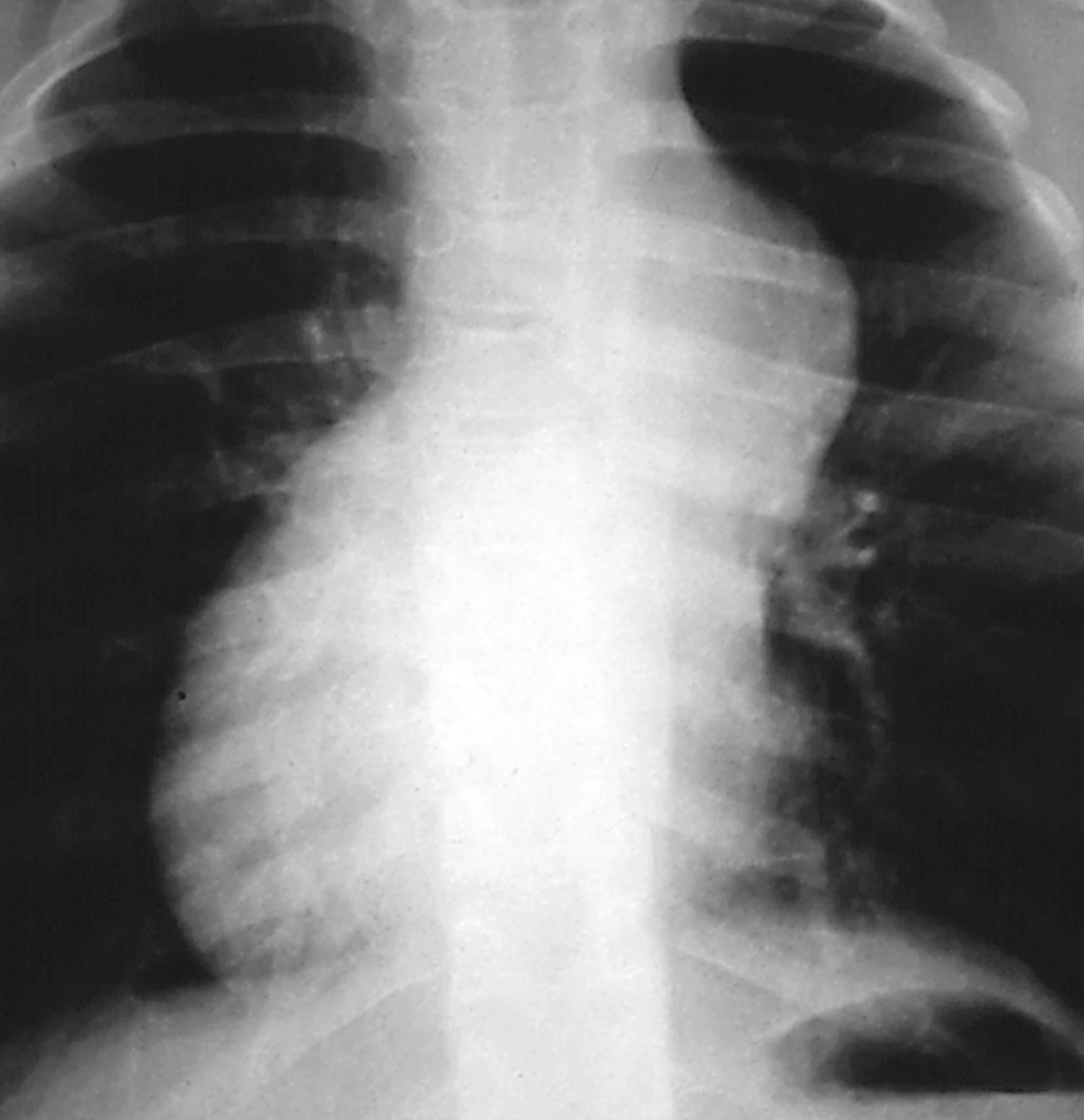
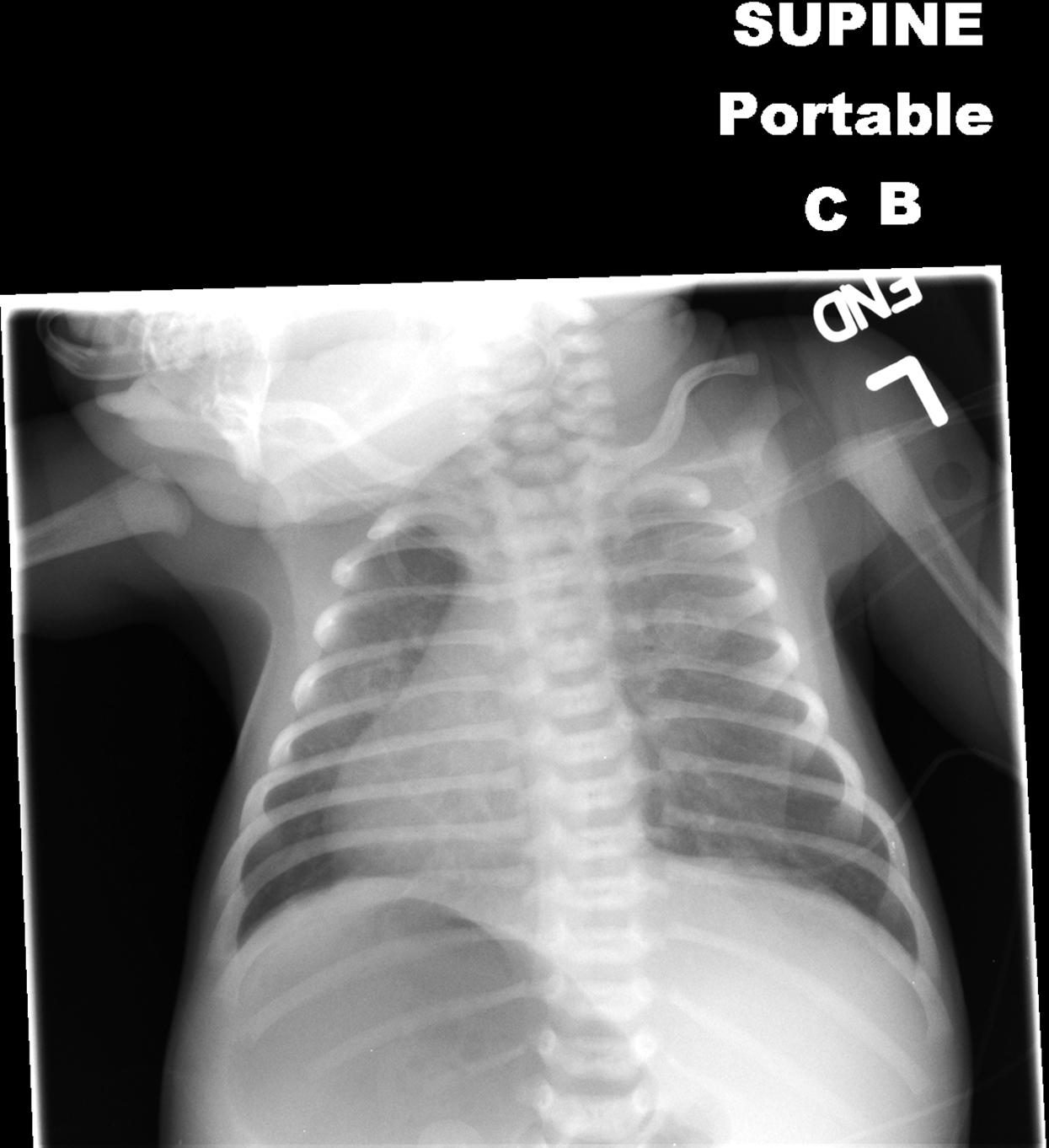
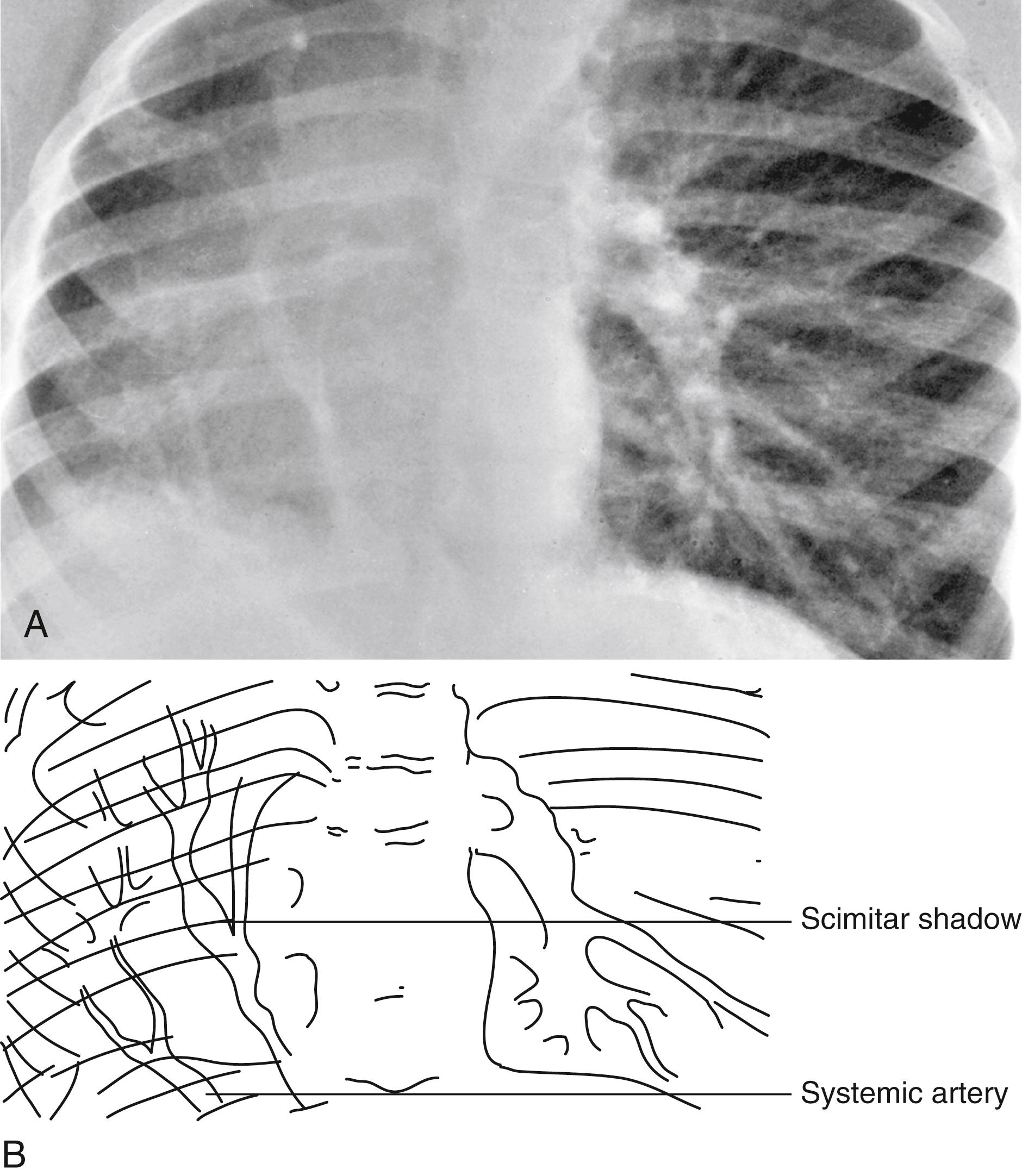
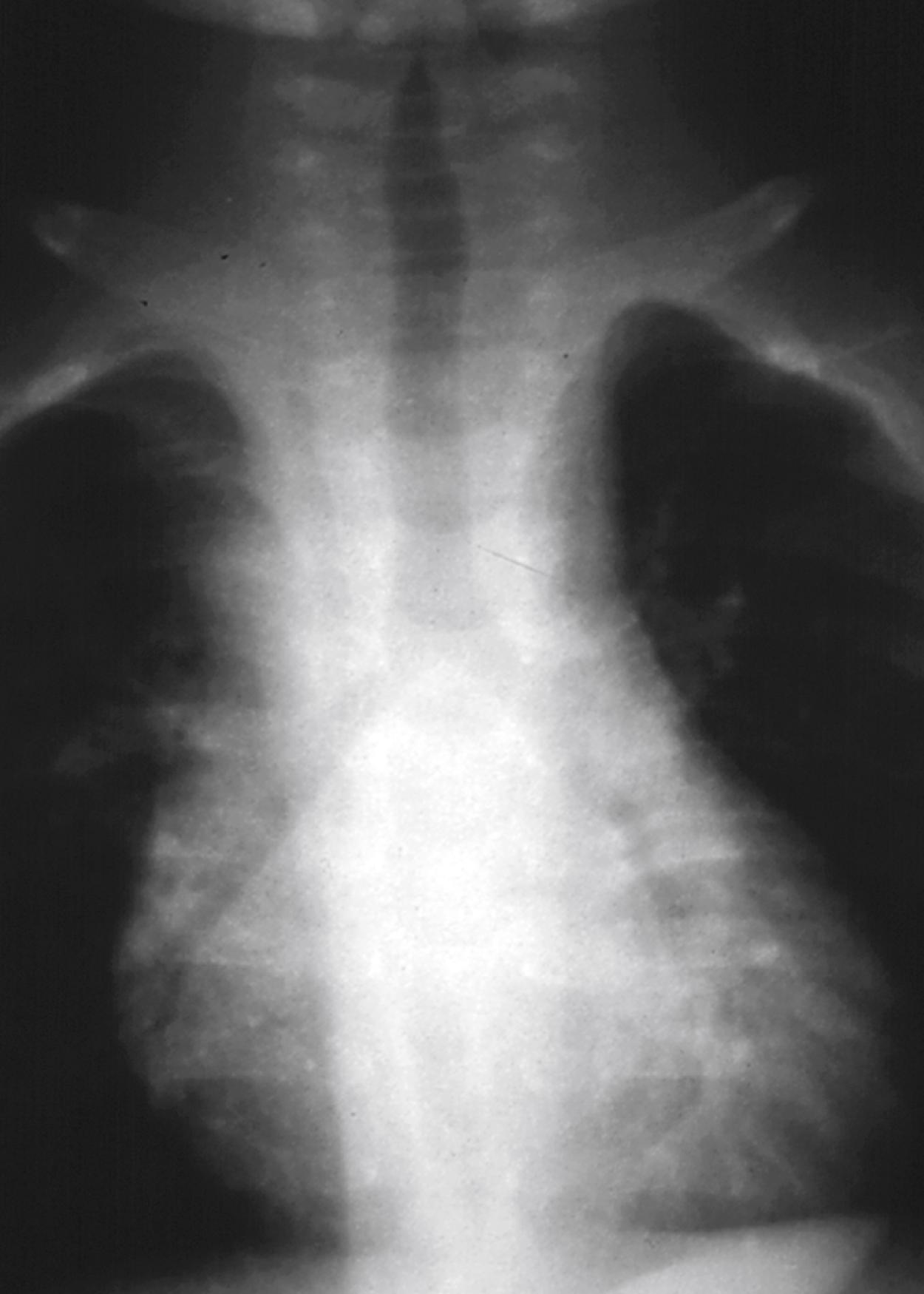
Cardiac size is important, but the shape of the cardiac image may also provide a clue as to which heart chambers are enlarged and the likely structural diagnosis. In the cyanotic newborn with transposition of the great arteries, the cardiac image appears as an “egg on a string” ( Fig. 5.21 ). If the thymic shadow does not obscure it, the mediastinal shadow shows a narrow waist resulting from the anterior-posterior position of the aorta and pulmonary artery. This produces the “string.” Pulmonary vascular markings are usually increased, although vascularity may be normal in the immediate newborn period.
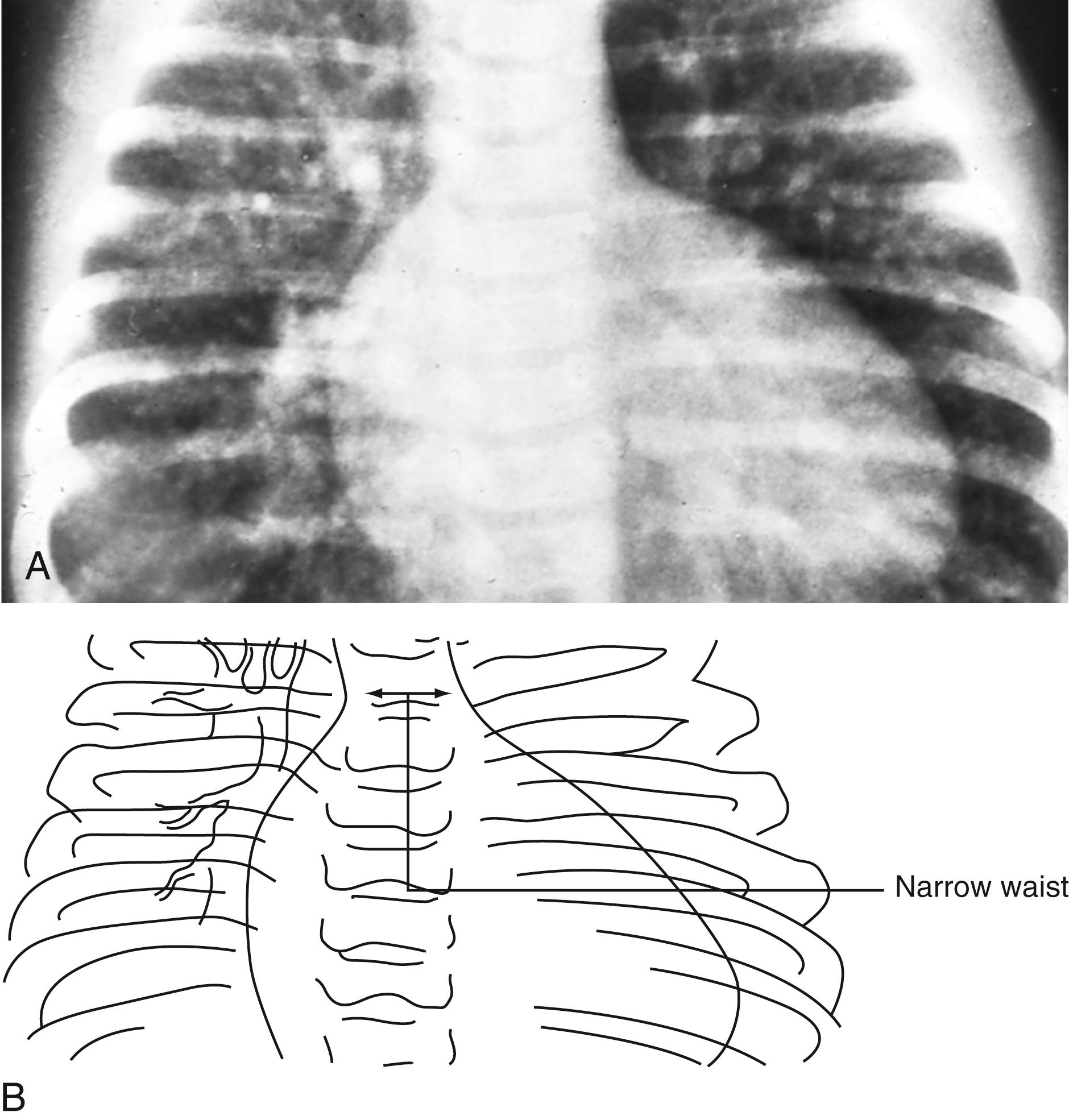
In TOF with pulmonic stenosis, the heart appears “boot shaped” because right ventricular hypertrophy causes the apex (toe of the boot) to turn upward ( Fig. 5.22 ). The concavity of the left upper cardiac border is due to the small right ventricular outflow tract and main pulmonary artery segment.
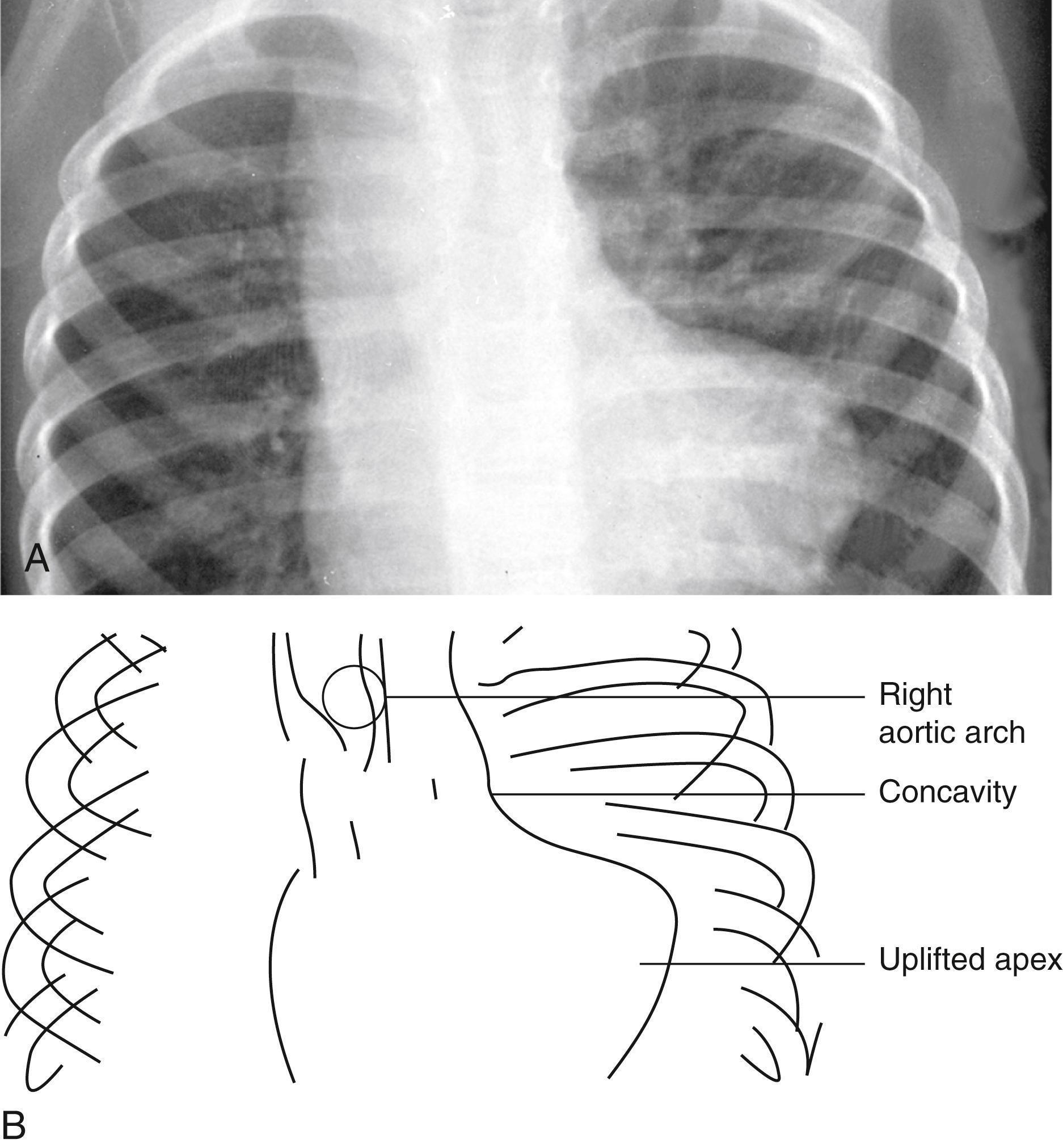
In TOF with pulmonary atresia, the heart is shaped like an “egg on its side” ( Fig. 5.23 ). The pulmonary blood flow to the lungs may be supplied by either patent ductus arteriosus or systemic arterial collateral vessels. The pulmonary vascular markings may be decreased if pulmonary blood flow is patent ductus dependent and increased if large systemic collaterals supply pulmonary blood flow.
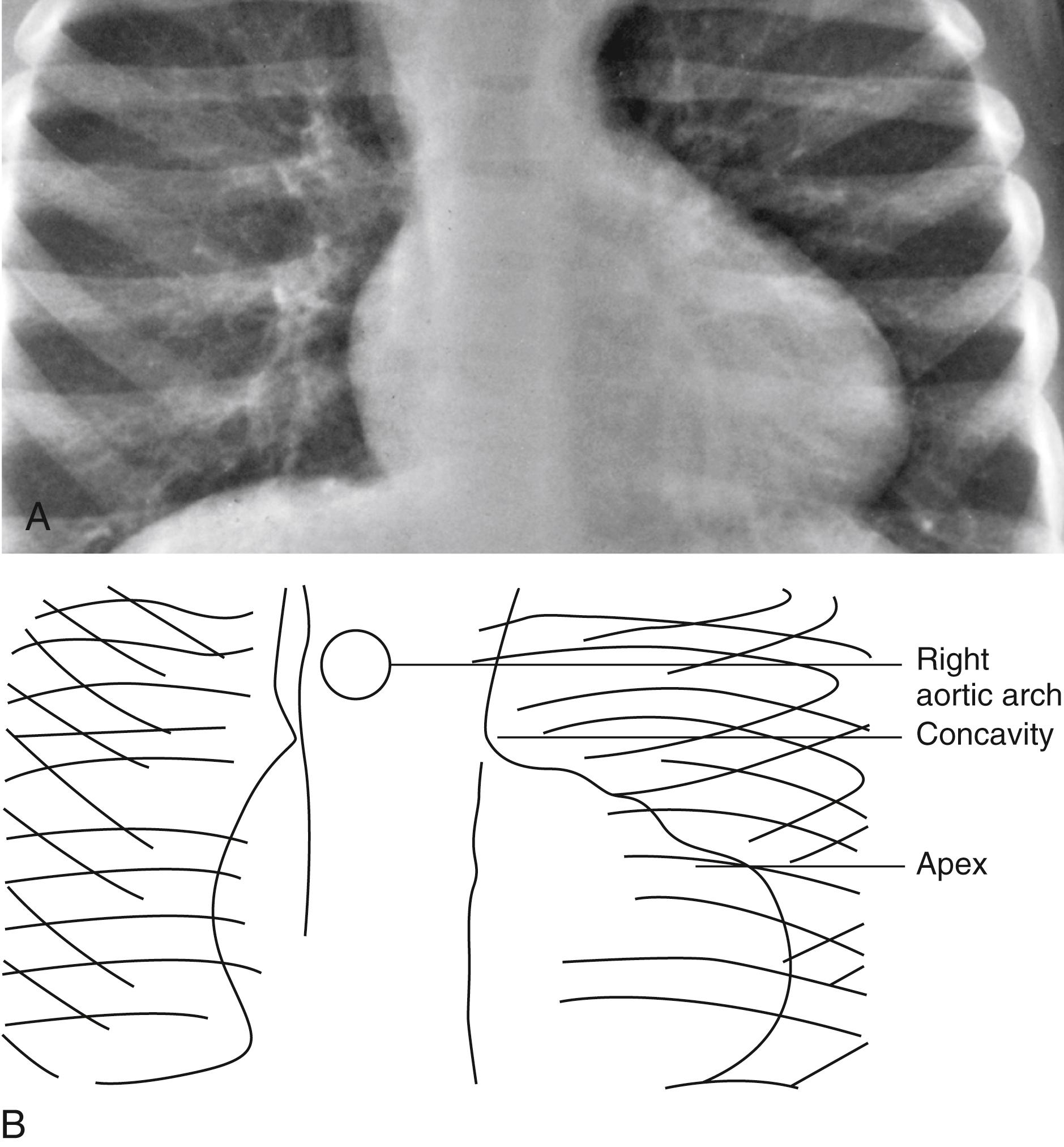
In congenitally corrected transposition of the great arteries, the heart has a “valentine” or “heart” shape with the apex pointing downward just to the left of the midline. The fullness at the left upper border of the cardiac shadow is due to the ascending aorta arising from the left-sided morphologic right ventricle. Dextrocardia is a frequent finding with this anomaly.
Although an enlarged and globular heart shadow may be associated with a cardiomyopathy, massive cardiac enlargement (so-called wall-to-wall heart) is typical in patients with Ebstein anomaly. In this anomaly, there is a malformation of the tricuspid valve with downward displacement of the inferior and septal leaflets of the valve into the ventricle, causing severe tricuspid valve regurgitation or stenosis. As a result, the right atrium becomes markedly enlarged and, along with the “atrialized” portion of the right ventricle, contributes significantly to the cardiac image of a large box-shaped heart ( Fig. 5.24 ).
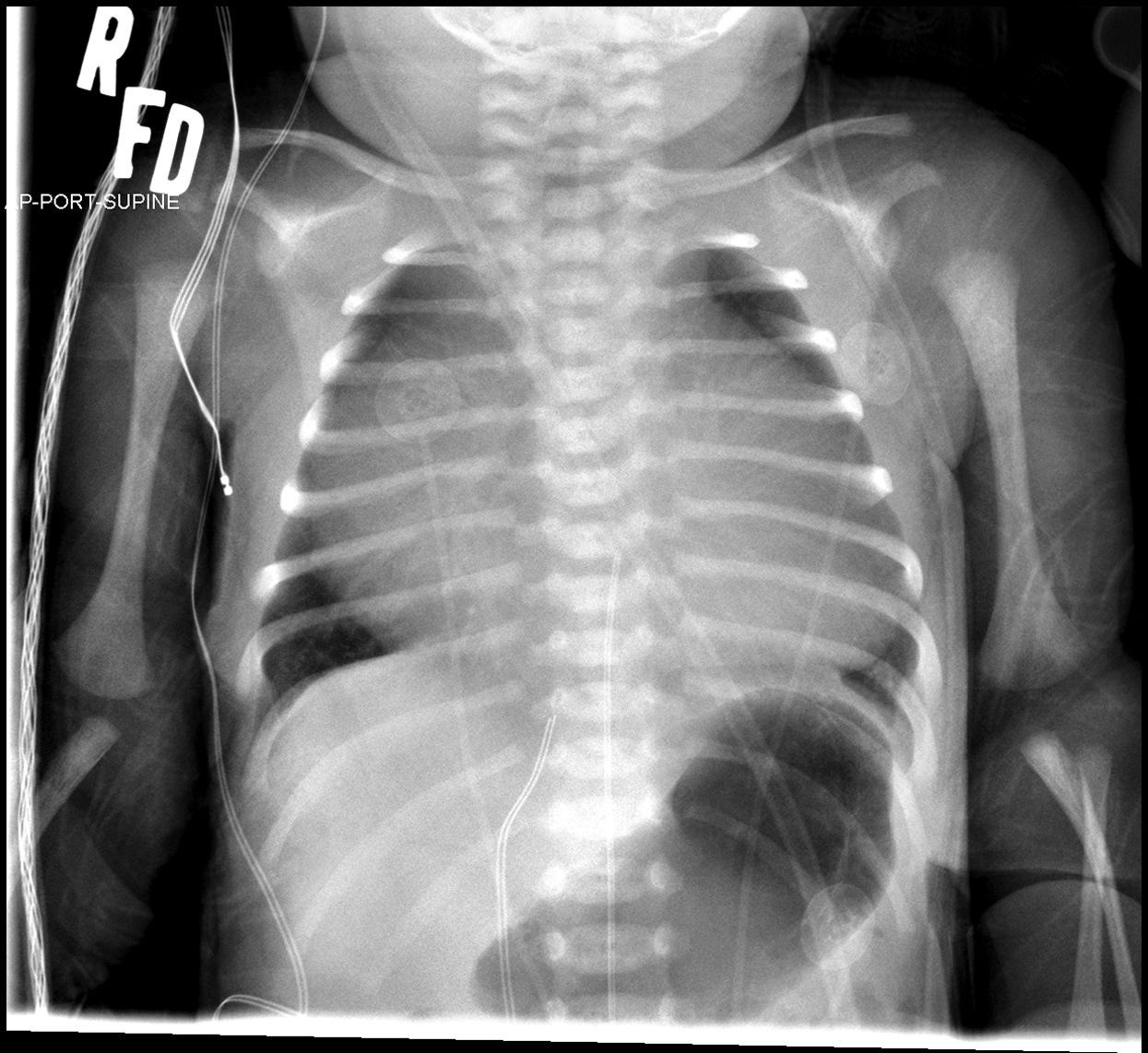
Left-to-right shunt lesions from atrial septal defects, ventricular septal defects, or a patent ductus arteriosus demonstrate specific chamber enlargement and increased pulmonary vascular markings. A significant atrial defect shows enlargement of all right-sided cardiac chambers, including right atrium, right ventricle, and pulmonary artery. A patent ductus arteriosus shows enlargement of all left-sided cardiac chambers, including the aorta. In patients with a ventricular septal defect, there is left-sided volume overload. An example of cardiomegaly with increased pulmonary vascular markings can be seen in Fig. 5.25 .
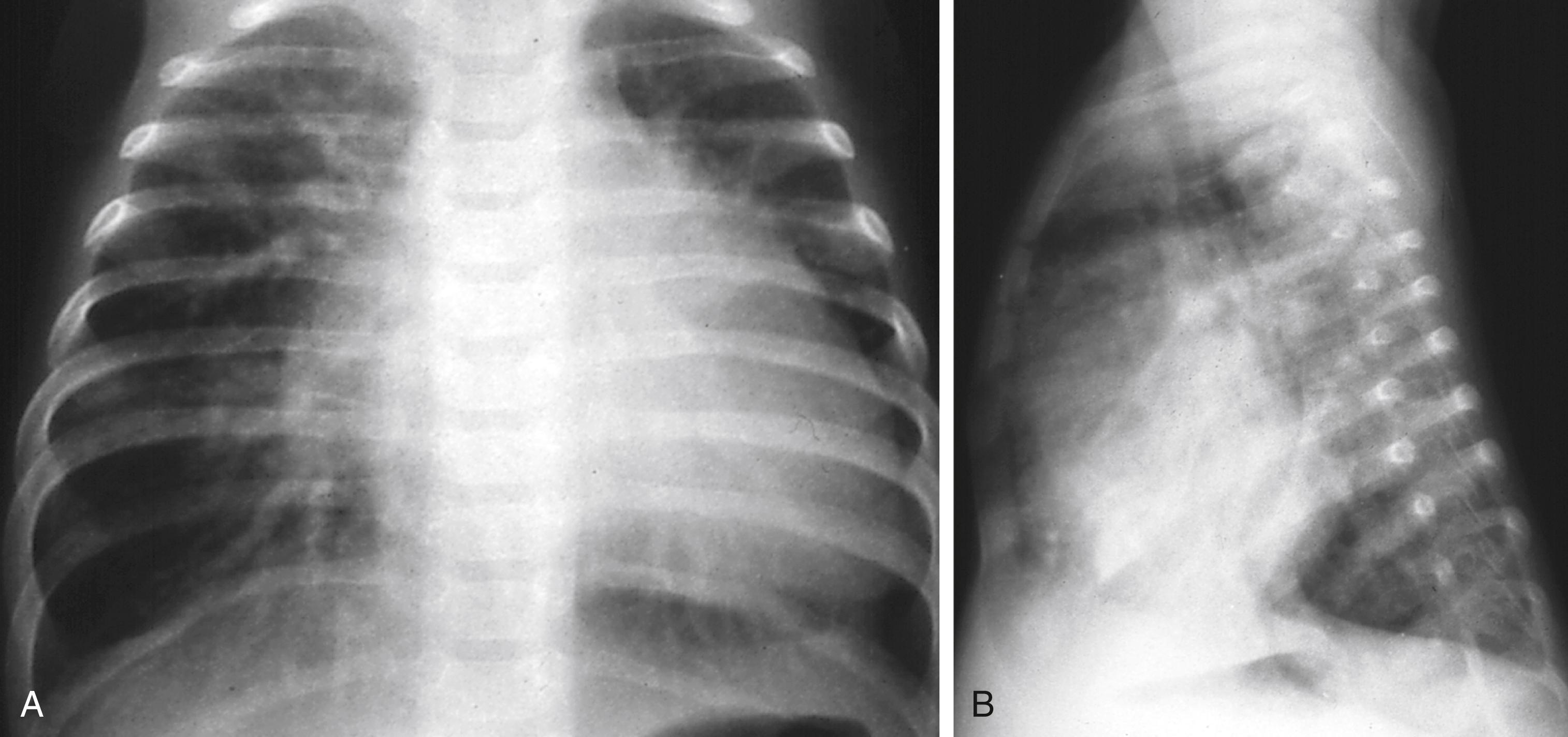
The radiographic appearance of the great arteries may also suggest a specific structural congenital heart defect. The main and left branch pulmonary arteries are usually enlarged in patients with pulmonary valve stenosis due to poststenotic dilation ( Fig. 5.26 ). The characteristic radiographic finding of congenital aortic valve stenosis is dilation of the ascending aorta, best seen as an overlapping shadow with the superior vena cava along the right upper cardiac border ( Fig. 5.27 ). Coarctation of the aorta not diagnosed in a timely fashion may show the distinct radiographic finding of a reversed E or 3 sign caused by prestenotic and poststenotic dilation of the descending aorta ( Fig. 5.28 ). If a significant coarctation remains unrepaired for 5 or more years, rib notching may appear (see the following Skeletal Abnormalities section).
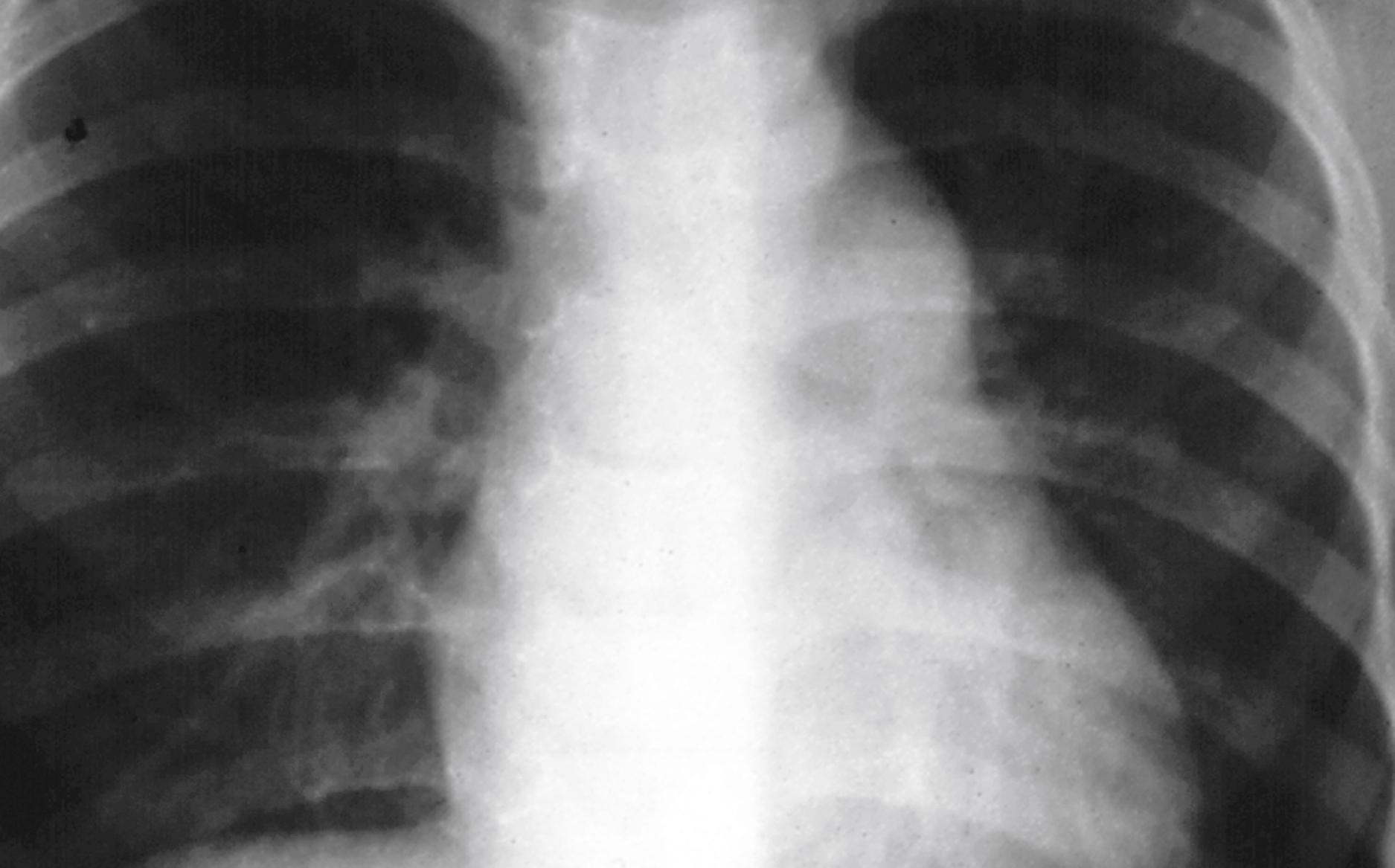
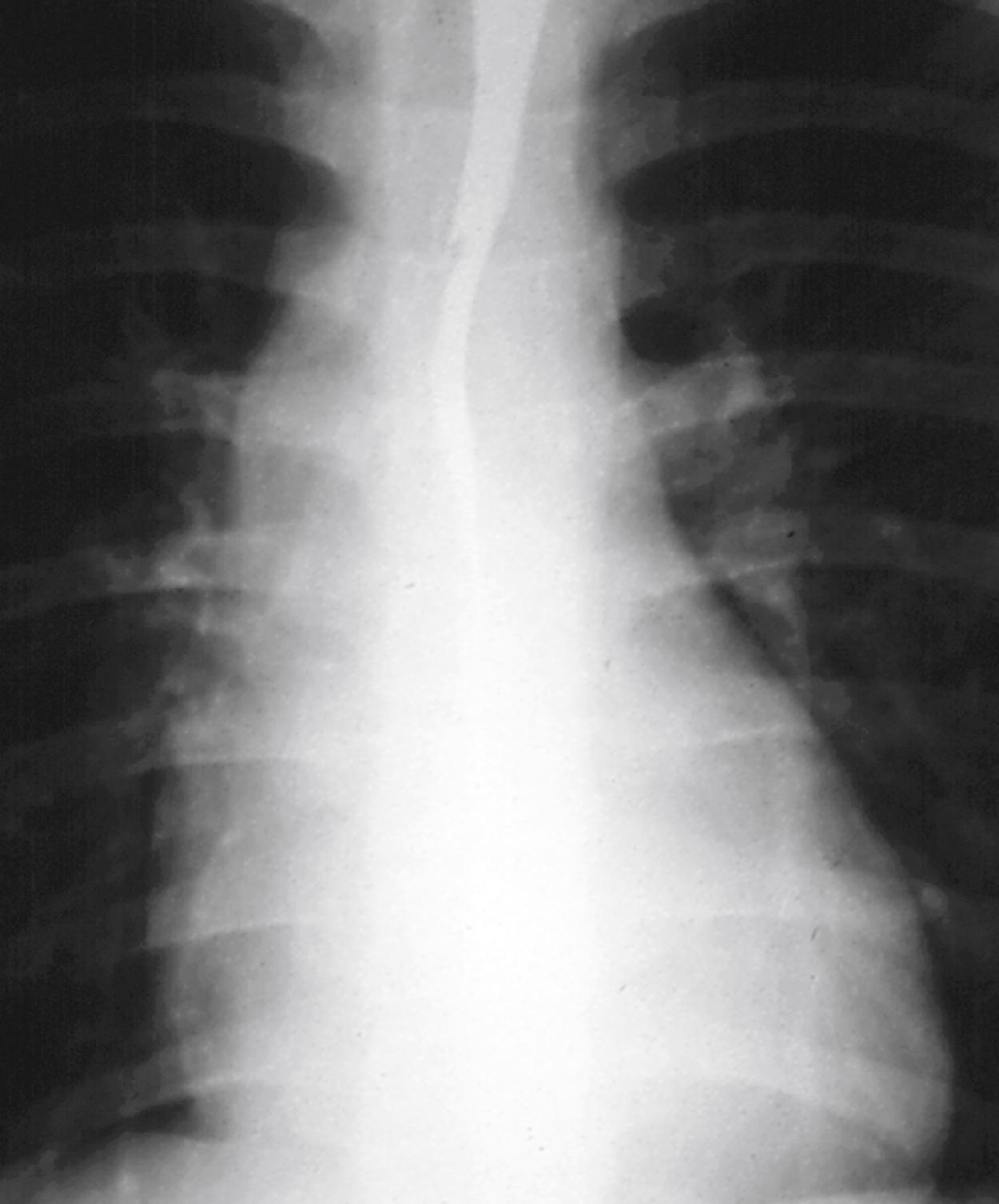
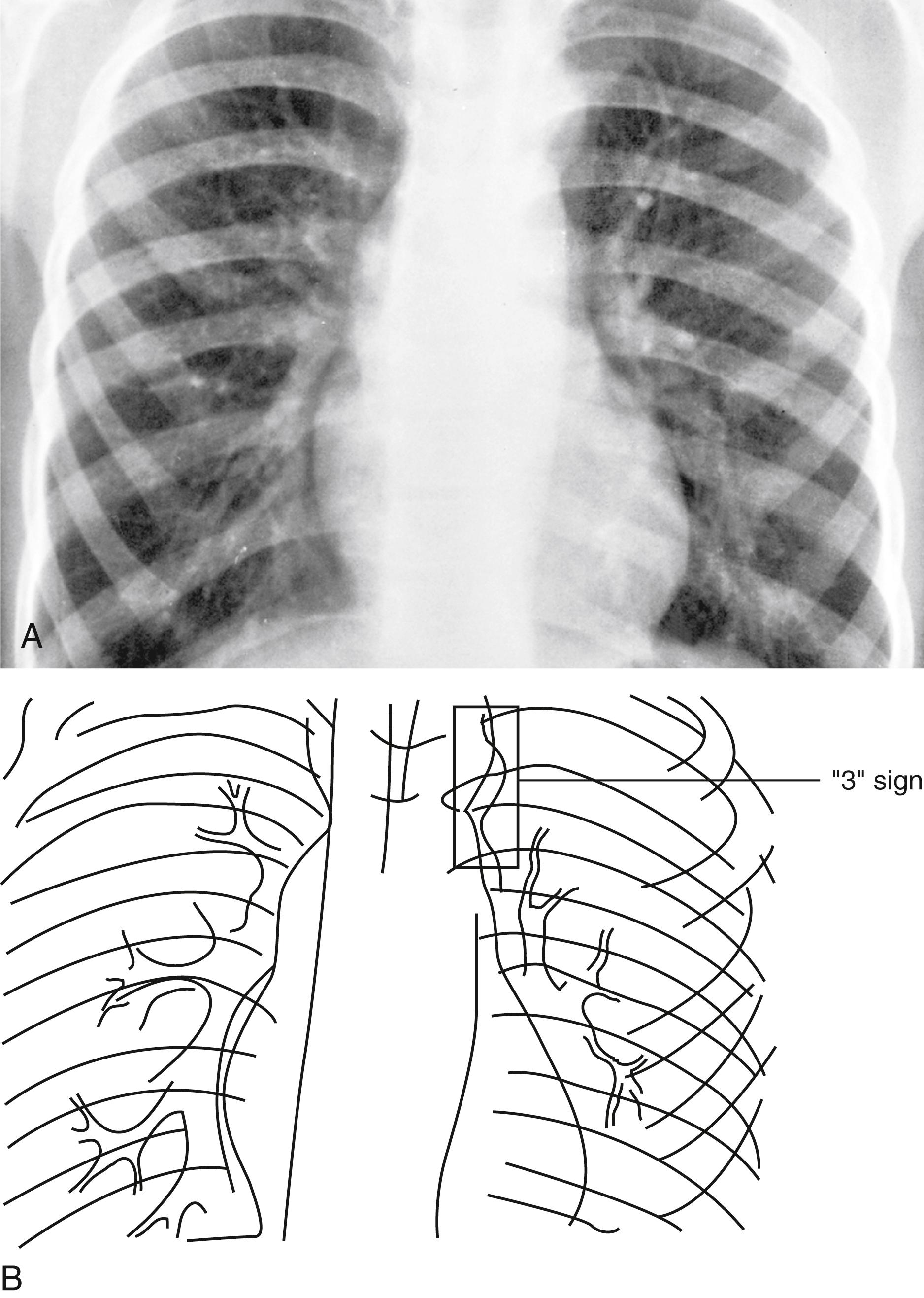
The normal left aortic arch causes a shift of the tracheal air column to the right, whereas a right arch causes a similar deviation to the left ( Fig. 5.29 ). The position of the thoracic descending aorta also helps to define the side of the arch and can be determined by noting obscuring of either the left or right side of the thoracic vertebral bodies. A right aortic arch should always raise the suspicion of congenital heart disease and is found in approximately 30% of patients with TOF or truncus arteriosus.
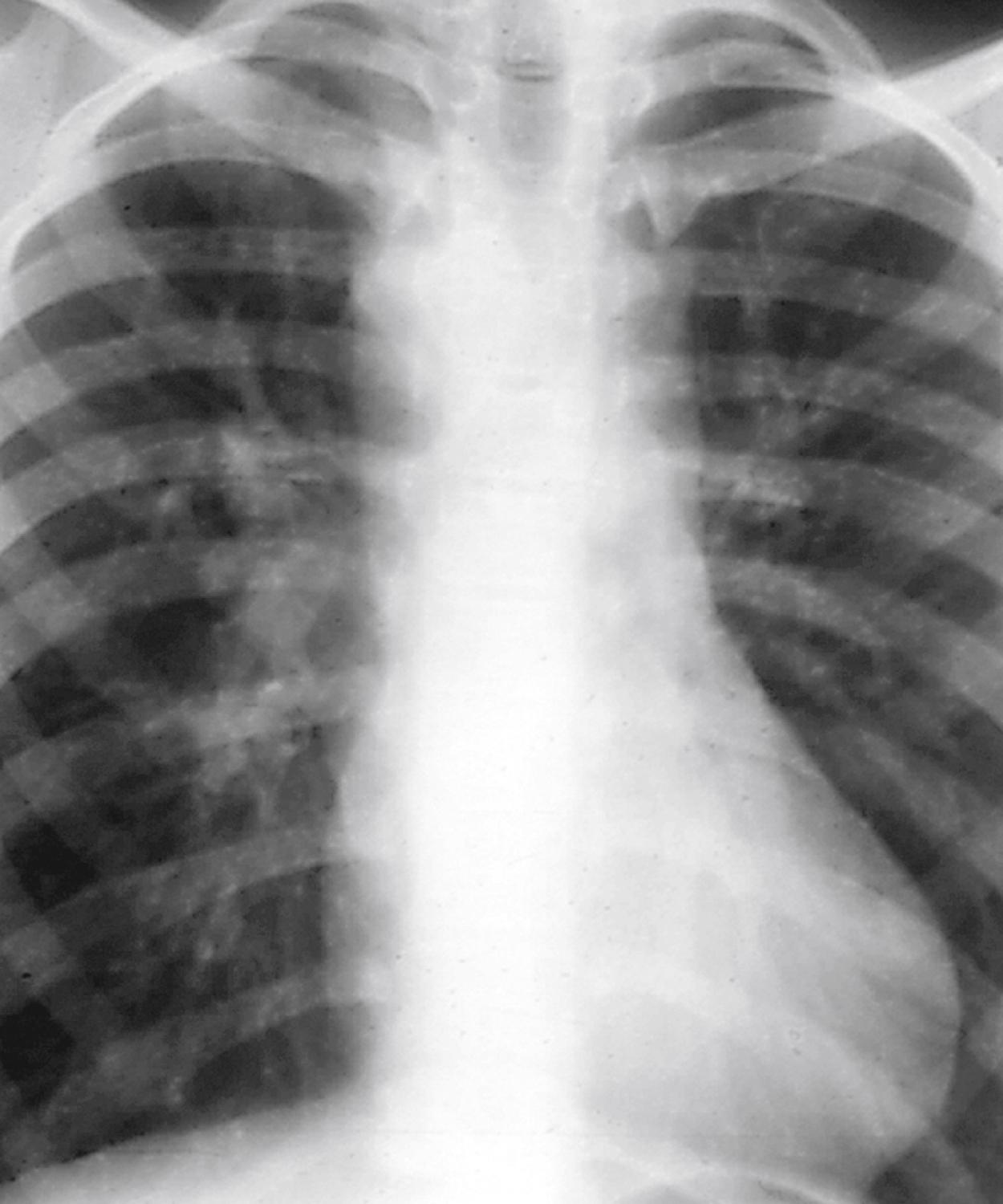
The addition of a barium swallow to the chest x-ray examination has historically been an important diagnostic tool in the assessment of patients with upper airway obstruction from vascular rings. Current practice favors the imaging techniques of MRI or CT scan, which provide clear and precise imaging of aortic arch and great vessel anatomy and their relationship to the airway and esophagus. Nevertheless, one may find vascular anomalies as findings on a barium swallow performed for the evaluation of dysphagia or upper airway respiratory symptoms. If a bilateral indentation is noted on the barium esophagram, a double aortic arch should be suspected ( Fig. 5.30 ). A right aortic arch with distal origin of the left subclavian artery or a left aortic arch with distal origin of the right subclavian artery produces a posterior indentation on the barium esophagram. It is of note that the aberrant right subclavian artery is only rarely associated with airway or esophageal symptoms. An anterior esophageal indentation is almost always caused by distal origin of the left pulmonary artery, resulting in this vessel coursing between the trachea and esophagus and causing a pulmonary artery sling ( Fig. 5.31 ).
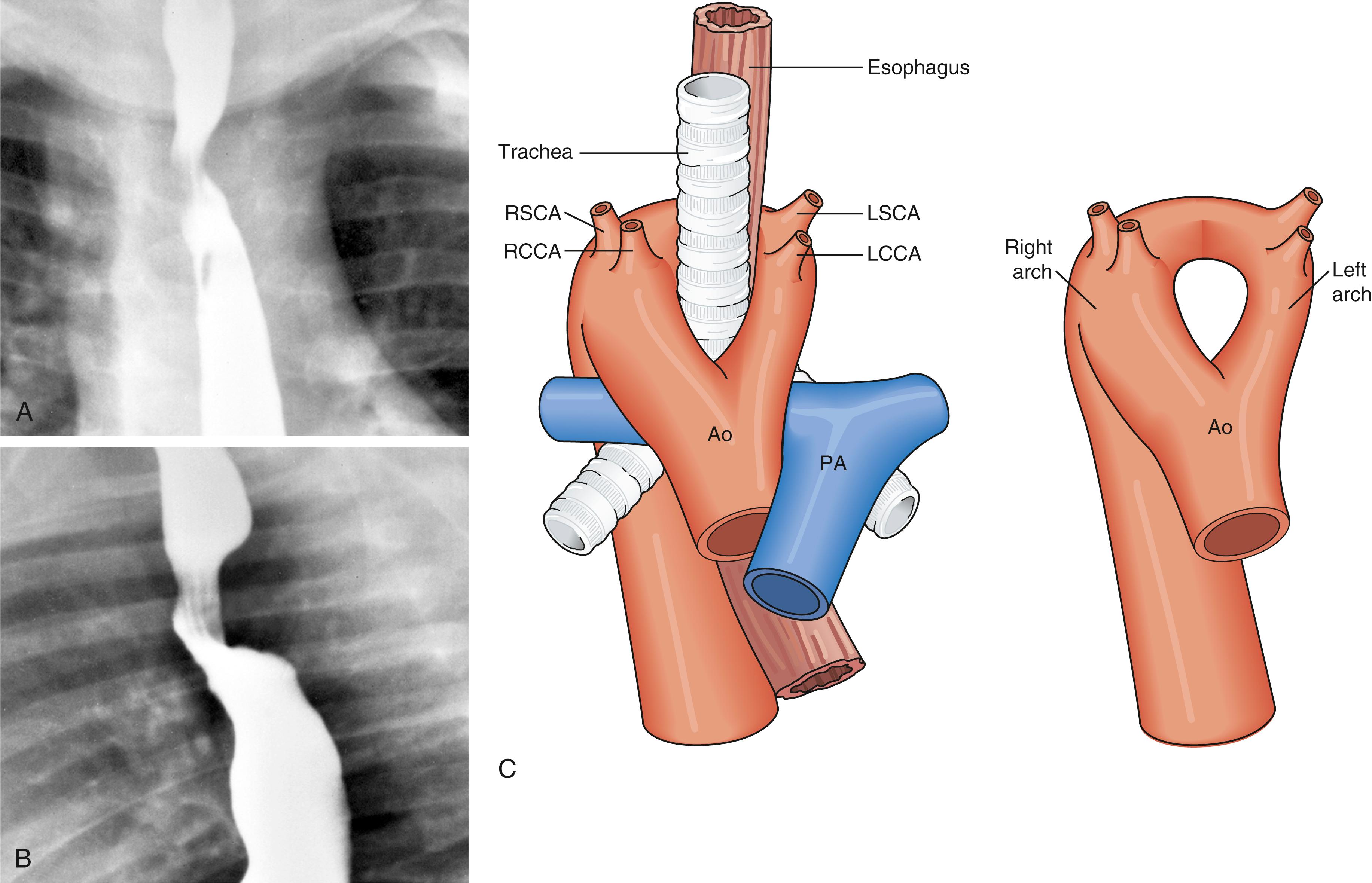
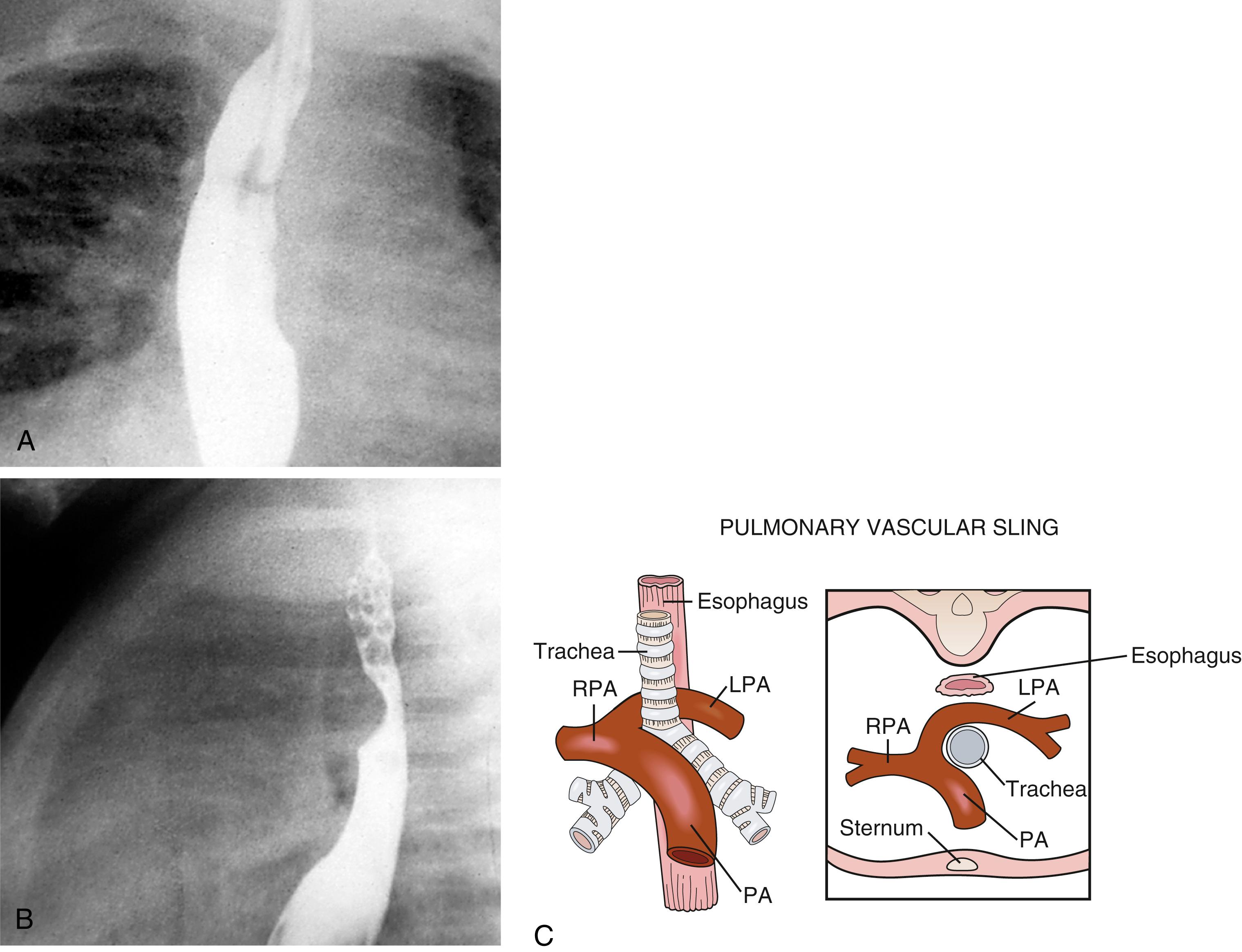
Left-to-right shunt lesions are associated with increased pulmonary blood flow that causes increased prominence of the arterial or a combination of arterial and venous markings on the chest radiograph. Hyperinflation seen on the chest x-ray film is a characteristic finding in infants with a large left-to-right shunt associated with pulmonary overcirculation (see Fig. 5.25 ). Patients with pulmonary venous obstruction, such as infradiaphragmatic total anomalous pulmonary venous return, show a fine reticular pattern of pulmonary venous obstruction, which may mimic respiratory distress syndrome in the neonate ( Fig. 5.32 ). It should be cautioned that the interpretation of pulmonary vascularity can be quite difficult and should always be interpreted within the context of other clinical findings.
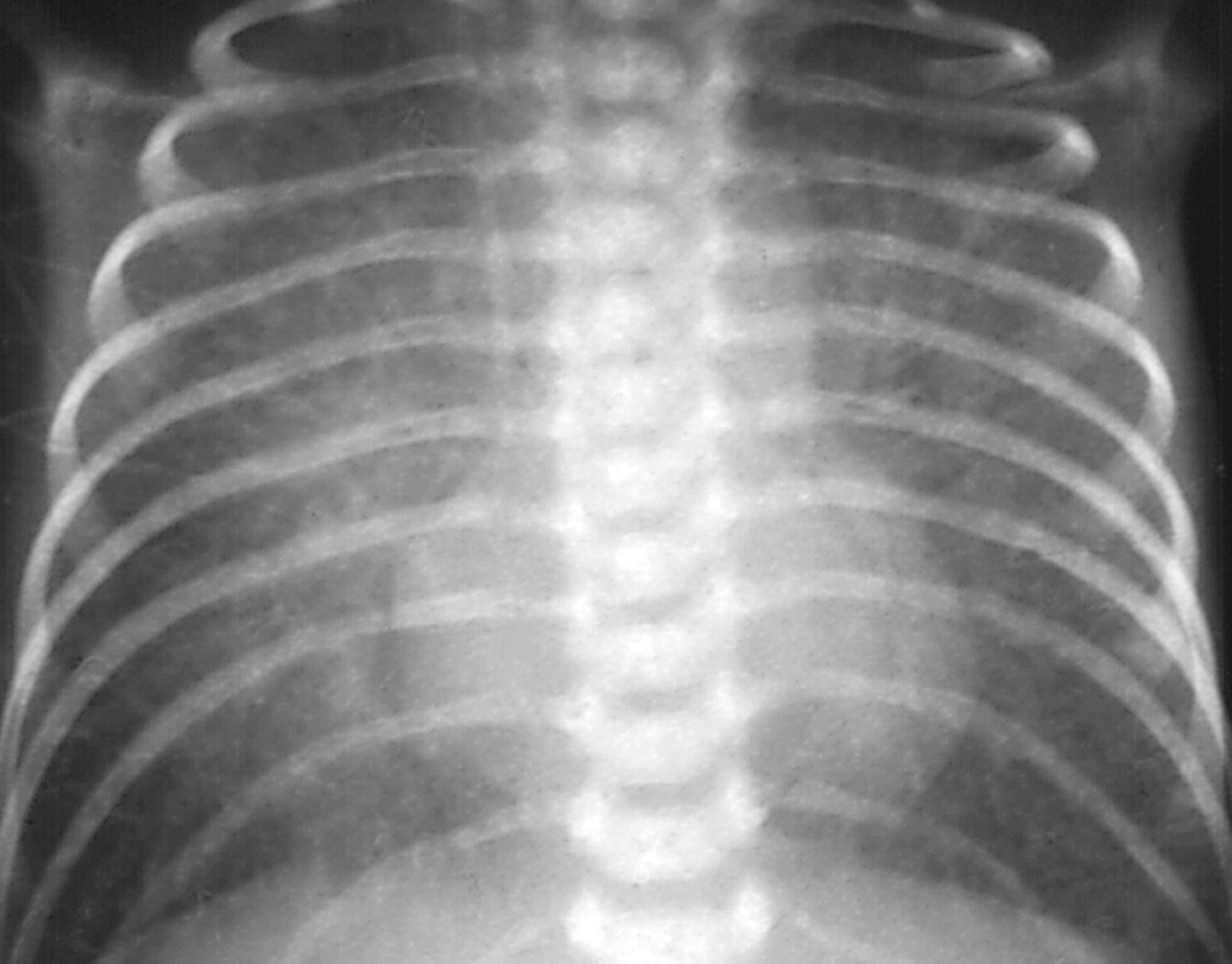
Oligemic lung fields indicate reduced pulmonary blood flow, as seen in most types of cyanotic congenital heart disease, the classic example being TOF.
Attention should also be given to the thoracic cage including the spine and ribs. Although abnormal fusions of ribs and hemivertebrae are not pathognomonic for specific congenital heart lesions, there is a higher incidence when these findings are present. Rib notching is a distinct radiographic finding in older patients with coarctation of the aorta ( Fig. 5.33 ). Scoliosis is a common finding in teenage patients with cyanotic congenital heart disease. Pectus excavatum may cause a false impression of cardiac enlargement because of a “pancaking” effect on the heart from a narrow anteroposterior thoracic diameter. Because of its association with chest wall and spine abnormalities, mitral valve prolapse (and associated connective tissue disorders, such as Marfan syndrome) should be considered in this context.
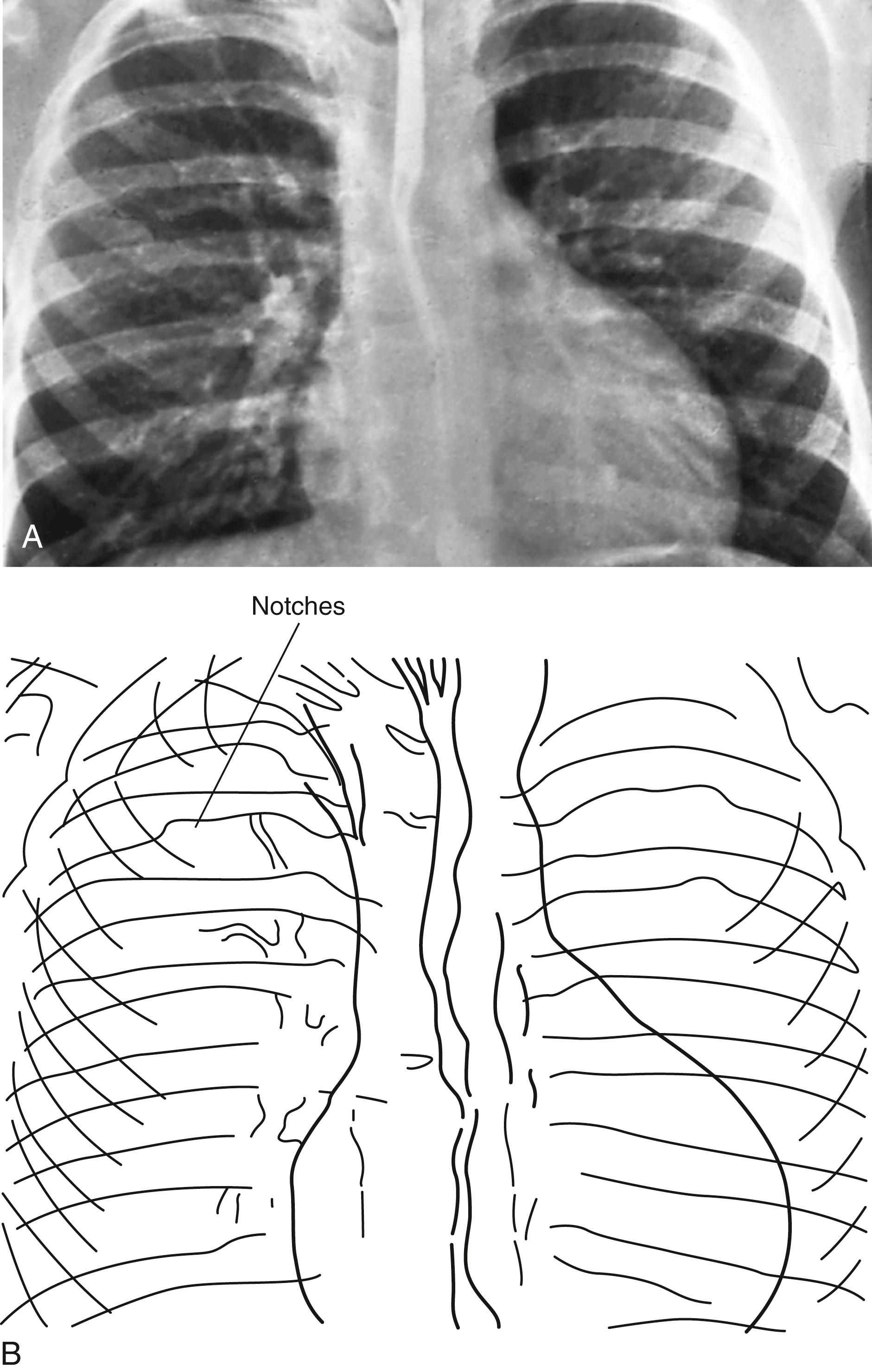
Become a Clinical Tree membership for Full access and enjoy Unlimited articles
If you are a member. Log in here